#AND IT OPENS WITH A NIGHTMARE SEQUENCE FOR LLOYD
Explore tagged Tumblr posts
Text
BABE WAKE UP NEW NINJAGO TEASER JUST DROPPED

#AND IT OPENS WITH A NIGHTMARE SEQUENCE FOR LLOYD#AWESOMEEEEEE#THIS LOOKS SO COOL#THE BAD GUY?? SO COOL#ninjago#ninjago dragons rising#dragons rising#dr#lloyd ninjago#lloyd garmadon
48 notes
·
View notes
Text
DRS2 reactions (spoilers)
Ep 1
Ras at the shadow dojo???????? Who woulda thunk
New intro?!?!!!?!! Idk why I wasn’t expecting that, actually
The public including Pix with the missing ninja my beloved
Gosh, big Riyu will take some getting used to
Wait… is that a curious george reference??
I don’t know if I’ve heard someone outright say something isn’t good for their friend’s mental health in a cartoon before, it’s really refreshing
Casual Frohicky and Sora/Arin interactions my beloved <3
Omg Kai explaining Shang to Zane is such season one vibes
Lloyd having open and honest conversations with his students about both his and their wellbeing is so important to me
Ok, hear me out: au where baby Wu didn’t age back at an enhanced rate and gets lost at somepoint and Arin is teenage Wu
Dang it, Cinder’s kinda funny
Ep 2
I legit started happy stimming so hard at that opening shot, I’m really invested in Euphrasia’s story already and nothing’s even happened yet lol
Percival out here making the gen z solarpunk dream a reality!!!!
Lloyd calling it what it is — a panic attack — soothes something in me
Sora did really bad graffiti of cats when she was young, that’s adorable and kinda tells you everything you need to know about her
MY GIRL!!!!!!!
Euphrasia using a cane!!!! Hell yeah mobility aids!!!! (Even though it’ll probably be gone in two episodes lol)
I kid you not, I was 100% expecting Suetonius to say “resurrect… the Great Devourer” lmao
I love that the gang is (mostly) all together, but it’s a bit too many characters for a conversation, I get why they like to split them into groups
Nya grounding Lloyd :(( /pos
Kai boasting about a fight that he won a decade ago when Cinder probably doesn’t even know Ash is endlessly amusing to me
Ras is so dramatic I can’t really take him seriously
Damn, they’re letting characters get hurt, it’s kinda refreshing but it’s scary
Ep 3
Wait I didn’t see Euphrasia get captured :((
WHAT THE HELL?!???? /vpos
Strength, motion, energy, and life?!??!!??
AYOOOOOO?!?!????
Kai comforting Wyldfyre <333
We know this takes place after the mech shorts, so why hasn’t anyone mentioned Cole? He was also seen in public, so why did that conspiracy guy say he’s still missing?
Why do they keep leaving Zane behind?? He’s in his housewife era fr
Kai making sure Wyldfyre’s taken care of :((
This show is so unserious, I love it
I wasn’t feeling people calling Kai Wyldfyre’s dad after season one but…
No… Sora took Arin’s thing from him… she didn’t mean to, but he feels like he’s not special anymore :(
I’m going to pretend that was a believable amount of parts to make a mech that big
Kai getting moments with Arin and Sora my beloved
Kai’s “hey kid, nice of you to drop by” is giving the same energy as when Lloyd and Arin first met during the merge
THE WALLS ARE MOVING, REPEAT: THE WALLS ARE MOVING
These nightmare sequences are going so hard
Nya being the first one to realize it isn’t real when her nightmare is reality, I’m screaming
Riyu comforting Wyldfyre <333
Nya best sister award when
Ep 4
My boys!!!!!
THE found family of all time
IF ANYTHING HAPPENS TO MY CHILDREN I WILL RIOT
Seeing Kai and Nya fight so smoothly together is so special after how much they and Lloyd were tripping over each other when they first reunited
Basketball?!??!!??!!!
Autistic Arin real and true
I love Bonzle so much
Geo is such a lil bastard actually /pos, makes more sense why he and Cole are a thing, knowing Cole’s taste in men
COLE!!!!!!
Cole will never stop being overpowered, it seems, he deserves it tbh
Censorship pog /hj
“Not funny, Wyldfyre” “Not joking, Sora” the sheer cousin vibes in this interaction are too much to handle
Lloyd PLEASE just mention being 1/4 dragon, it will almost certainly get Egalt on board, I am begging
Glacier reunion!!!!!!!
Ep 5
I wanted a more emotional reunion, but they’ve probably seen each other off screen (or I’m just forgetting a scene from the shorts)
Zane, why are you still carrying that doll like it’s your child??
Bonzle my beloved, she’s says that so deadpan I don’t actually have any questions
Wyldfyre my beloved
I would die for Bonzle
Cole and Geo holding hands 😭😭😭😭😭
Is Egalt the motion source dragon?? Probably not tbh but I’d believe it
Man’s spitting facts, flatearthers are going to lose their shit
“Little fire man” IM DYING OH MY GOD
Wait when does this take place? My first instinct is while the ninja were in the Never Realm but idk if we’ll actually find out
“Friends can become like family?” “Definitely” IM SOBBING ON THE FLOOR
Letting Arin be angry is so important
Cole shutting down Bonzle’s suicidal thoughts without hesitation “no, you are loved and needed. We will find a way to protect you” <333
The physical affection in DR is so dear to me
Human sacrifices???? In MY lego show?????
Ep 6
Wyldfyre struggling with her body’s limits is really relatable as a young disabled person
FOREHEAD TOUCH :((
Plot twist: where the other ninja are right now is Mysterium and they have that tua meme of two cars passing each other moment
Damn, that exchange hit hard as a former gifted kid. Sometimes having someone believe in you hurts. You’re not just letting yourself down, but them, too
Nya just fucking bodyslamming Kai, Egalt didn’t know what he was getting into pitting the world’s most competitive siblings against each other
“The Finders are like my family” *looks at Zane* “My other family” screaming, crying, sobbing on the floor
Oh no
Wait yeah, why are they thirsty if Zane can just make ice for them to chew on? At least Cole and Jiro, idk if Bonzle needs water
The nonbinary pirate!!!
Cole CANNOT escape the performing arts fr fr
Ep 7
Bonzle is giving transgender
That is the most Jay and Cole thing I’ve ever heard it, it’s so in character it almost feels out of character
Arin and Sora going through the exact same thing and trying and failing to not take it out on each other :( it’s ok tho, the real ones are the ones you can be snippy with and love regardless
Wyldfyre referring to the ninja as “Kai’s friends” honey, they’re your friends too, I promise
Anyone who calls Wyldfyre dumb can fuck off, she’s so perceptive and intelligent and is really good at connecting others when she truly wants to
Bonzle’s mom <33333
Bonzle’s smile when her mom compliments her name <3333
Who you calling stolen equipment bitch?????
Lil Kai and Nya!!!!!!
Nya’s so proud of him!!!!! I could cry
Kai being the first to achieve it because fire is an element under motion’s domain methinks
Oh you bigoted son of a bitch
Zane why are you considering it????? Honey
What the fuck did you do to Jiro??!?!!!
JAY?!?!!???
Ep 8
NOOOO 😭😭😭
There’s literally a nindroid agent right there????
The og musical cue playing when Jay comes back <3
Jay on his Euphrasia arc, this is highkey breaking my heart though
I’m counting this as a fakeout death and you can’t stop me
Are you kidding me???!!!? How many times is Jay going to be one room away from the ninja
Lloyd SHUT UP /aff
“And cursed!!” She says cheerfully, this lady is an icon
The subtitles keep calling Cole Kai, what is this, season one??
Ep 9
Aww, baby Ras (trying desperately to not care about him)
Oh ok, he’s making my job easier
Poor Wyldfyre :(
I love this trio so much, their banter is so good
Lloyd honey, fighting it is making it worse
Nya holding him through his panic attack :((
I was expecting Cole to deny that it was him, the earth is going through it
The disco toaster!!!!!
Heck yeah Riyu!!!
I love them so much it’s not even funny
“What’s your elemental power, imperviousness to sarcasm?” She just called him autistic in 13 languages (I’m autistic, dw guys)
“First time driving?” “Believe it or not, no” Bonzle and Arin my beloved
I’m a touch disappointed Wyldfyre’s perfectly fine now as someone with chronic pain, but I’m glad it was handled as well as it was and it’s a really important lesson for younger audiences that pushing your body while it’s in pain only makes it worse
The silent exchange of Cole suggesting Zane takes the parrot potion is endlessly funny but also sad considering it’s probably the closest well get to talking about the Falcon
Cole turning into a puppy who cheered?!???
“At least you’re adorable” “I’m always adorable” get a room /aff
Tournament of elements flashbacks
The workplace gossip omg, Cinder really out here beefing with a 16 year old
Don’t you even fucking dare
MY BABIESSSSSS
Ep 10
Arin mistaking Lloyd and Nya for his parents hurts :(
Oh no… I mean, it was obviously coming but it’s still very bad
WYLDFYRE POPPING OFF!!!!! THIS GIRL NEEDED HER ENRICHMENT
Let Euphrasia do stuff 2024
Wyldfyre jumping in front of Kai and protecting him
The basketball practice coming in handy lol
The fight cinematography in DR is fucking superb
KAI D: (he’ll be fine, I believe)
Nya!!!!!
BONZLE MVP!!!!
I was prepared for Rontu and Egalt to stay dead, the breath I let out when the stone cracked was unparalleled
Are we legit not getting Kai back????
Cole and Lloyd hug!!!!!
RAAAAAAAAAAAAHHHHHHHH
Oh no… that lie is going to hurt when it comes out
Kai and Bonzle!!!!
Not like Master Wu says, like Lloyd says ;-; /pos
7 notes
·
View notes
Text
Perplexing Enjoyment in "The Manchurian Candidate"

“The Manchurian Candidate” is an interesting film, to put it politely. Most of the way through, it’s wholly engrossing, if in large part because of its perplexing tonal shifts, from melodramatic to comedic to sensitive, sometimes making these jumps within the same scene. Some of the dialogue (especially Eleanor’s interactions with Johnny Iselin) is corny and contrived. At other times, it’s surprisingly modern and clever, such as the meeting of Ben (Frank Sinatra) and Eugenie (Janet Leigh) on the train, though it doesn’t quite work because everything seems to happen so quickly, and for no apparent reason— Eugenie makes quips while Ben leans against the wall, sweating, looking like he’s about to be sick, tortured by his nightmares about Raymond.
The romance, certainly, needs very little introduction. Courtship would only bog down the plot, so it’s dealt with quickly— within minutes of meeting their respective partners, Ben and Raymond (Laurence Harvey) find themselves in love, making proposals. Unfortunately, Eugenie’s brevity, which on its own is vaguely amusing, makes no sense opposite Ben, a character who seems to be half-alive at best, sleepwalking his way through the waking world. He plays frustratingly straight in a film that seems to have no use for such things. For a moment, there’s the promise of humor in his performance, as he’s listing off subjects of all the books he’s read. This humor, however, is very quickly dispensed with to make way for… Well, nothing.
“The Manchurian Candidate” is at its best when it’s being absurd. A great film by no means, the sheer oddness of it makes a fun watch, until the last fifteen minutes or so, which become a drag, as though the writers got to that point and reluctantly trotted out a conclusion.
As it happens, Raymond, a character who spends a fair amount of the picture just looking blank, or being softly disagreeable, is the heart of the picture, telling Ben about his love affair with Jocie (Leslie Parrish), playing drunk very amusingly (until the end, when he breaks down crying, which is not convincing in the least), and making himself quite relatable, though he says the word “lovable”, one thinks, a bit too often (in the same way Raymond’s mother and Johnny say “hon” and “babe”, as though the scriptwriters were trying to seem hip and modern by using the slang endearments).
There are a number of likable characters in the film, even though many of them make only brief appearances. James Edwards’ scenes as Melvin, unfortunately, are pure melodrama and some of the worst in the film. Mr. Gaines (Lloyd Corrigan), on the other hand, introduced to us sitting in bed, wearing his wife’s fuzzy robe— which he defends by saying it’s the warmest thing in the house, perfect for reading in bed— was a highlight.
The opening dream sequences I found very difficult to follow. The speechifying, and the constant switch between the garden party and the meeting of delegates was a bit much, especially since it’s barely mentioned in the rest of the film. That does seem to be how the movie operates— discard a thing when it no longer moves the plot along— and confusion can occasionally lead to an engrossing picture, but in this case, the absurdity never lets up and the conclusions do little to tie things up satisfactorily.
Whatever “The Manchurian Candidate” is not, it’s a fun film, and the perplexity of it adds to that sense of enjoyment. It’s strange, and I appreciate it for that. I would certainly recommend it to others, if I won’t be running back to see it a second time.
8 notes
·
View notes
Photo

Scream Factory has revealed the updated specs for its 4K Utlra HD releases of the first five Halloween films, which will be released on September 28. Joel Robinson designed the new cover art for each movie; the original posters are on the reverse side.
1978’s Halloween is directed by John Carpenter (The Thing, The Fog), who co-wrote the script with producer Debra Hill (The Fog). Donald Pleasence, Jamie Lee Curtis, P.J. Soles, Nancy Loomis, and Nick Castle star.
1981’s Halloween II is directed by Rick Rosenthal (Halloween: Resurrection) and written by John Carpenter and Debra Hill. Jamie Lee Curtis, Donald Pleasence, Charles Cyphers, Lance Guest, and Dick Warlock star.
1982’s Halloween III: Season of the Witch is written and directed by Tommy Lee Wallace (It, Fright Night Part 2). Tom Atkins, Stacey Nelkin, and Dan O'Herlihy star.
1988’s Halloween 4: The Return of Michael Myers is directed by Dwight H. Little (Anacondas: The Hunt for the Blood Orchid) and written by Alan B. McElroy (Wrong Turn). Donald Pleasence, Ellie Cornell, Danielle Harris, and Michael Pataki star.
1989’s Halloween 5: The Revenge of Michael Myers is written and directed by Dominique Othenin-Girard (Omen IV: The Awakening). Donald Pleasence, Danielle Harris, Ellie Cornell, Beau Starr, Wendy Kaplan, and Tamara Glynn star.
Each film has been newly restored in 4K from the original camera negative and new Dolby Atmos audio tracks. Special features are listed below. Notably, Halloween 5's long-thought-lost "Dr. Death" scene and deleted gore shots are included.
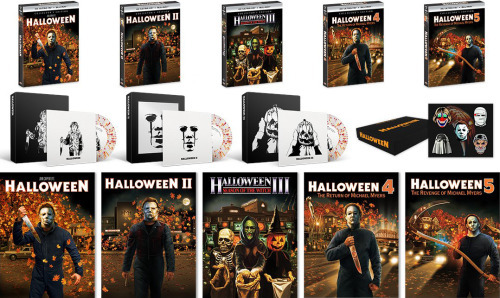
Halloween:
Disc 1 (4K Ultra HD):
Audio Commentary With Co-Writer/Director John Carpenter And Actress Jamie Lee Curtis
Audio Commentary With Director Of Photography Dean Cundey, Editor Tommy Lee Wallace, And Actor Nick Castle
Disc 2 (Blu-ray):
Audio Commentary With John Carpenter And Jamie Lee Curtis
Audio Commentary With Dean Cundey, Tommy Lee Wallace, And Nick Castle
The Night She Came Home Featurette
Halloween Unmasked featurette
Theatrical Trailer
Trailers from Hell with Adam Rifkin
TV Spots
Radio Spots
Additional Scenes shot for the network version
NBC Broadcast TV Promo
Newspaper Ad Gallery (new)
Still Gallery
Disc 3 (Blu-ray):
Original Color Timing Presentation of the Film
Halloween: The Extended Version (with standard definition inserts)
Broadcast Television Cut (in standard definition)
Interview With Producer Moustapha Akkad
Halloween: A Cut Above The Rest featurette
Horror’s Hallowed Grounds – a look at the original film locations
Horror’s Hallowed Grounds Halloween Bus Tour
TV Spots
Radio Spots
On a black and unholy Halloween night years ago, little Michael Myers brutally slaughtered his sister in cold blood. For the last fifteen years, the people of Haddonfield have rested easily, knowing that Michael was safely locked away in a mental hospital… until tonight. Michael has escaped and he will soon return to the same quiet neighborhood to relive his grisly murder again. For this is a night of evil. Tonight is Halloween.
Halloween II:
Disc 1 (4K Ultra HD):
Audio Commentary With Director Rick Rosenthal
Audio Commentary With Stunt Coordinator Dick Warlock
DISC TWO (BLU-RAY):
Audio Commentary With Director Rick Rosenthal
Audio Commentary With Stunt Coordinator Dick Warlock
The Nightmare Isn’t Over: The Making Of Halloween II with Rick Rosenthal, Dick Warlock, Composer Alan Howarth, Director Of Photography Dean Cundey, Actors Lance Guest And Leo Rossi, And More
Horror’s Hallowed Grounds - a look at the original film locations
Deleted Scenes with optional audio commentary by Rick Rosenthal
Alternate Ending with optional audio commentary by Rick Rosenthal
Teaser Trailer
Theatrical Trailer
TV Spots
Radio Spots
TV promo
Newspaper Ad Gallery (new)
Movie Stills Gallery
Posters and Lobby Cards Gallery
Disc 3 (DVD):
Television Cut (Standard Definition)
Film Script (DVD-ROM)
Picking up exactly where the first film left off, Halloween II follows the same ill-fated characters as they encounter the knife-wielding maniac they left for dead in the first film. The inhuman Michael Myers is still very much alive and out for more revenge as he stalks the deserted halls of the Haddonfield hospital. As he gets closer to his main target, Dr. Loomis (Donald Pleasence) discovers the chilling mystery behind the crazed psychopath’s actions.
Halloween III: Season of the Witch:
Disc 1 (4K Ultra HD):
Audio Commentary With Director Tommy Lee Wallace
Audio Commentary With Actor Tom Atkins
Disc 2 (Blu-ray):
Audio Commentary With Tommy Lee Wallace
Audio Commentary With Tom Atkins
Stand Alone: The Making Of Halloween III: Season Of The Witch with Tommy Lee Wallace, Actors Tom Atkins And Stacey Nelkin, Stunt Coordinator Dick Warlock, Director Of Photography Dean Cundey, And More
Interview with Justin Mabry of Trick or Treat Studios (new)
Interview with makeup effects artist Tom Burman
Horror’s Hallowed Grounds - a look at the original film locations
Teaser Trailer
Theatrical Trailer
TV Spots and TV promo
Radio Spots
Newspaper Ad Gallery (new)
Movie Stills Gallery
Posters and Lobby Cards Gallery
A terrified toy salesman is mysteriously attacked. At the hospital, he babbles and clutches the year’s most popular Halloween costume, an eerie pumpkin mask. Suddenly, Doctor Daniel Challis (Tom Atkins) finds himself thrust into a terrifying Halloween nightmare. Working with the salesman’s daughter, Ellie, Daniel traces the mask to the Silver Shamrock Novelties company and its founder, Conal Cochran (Dan O’Herlihy). Ellie and Daniel uncover Cochran’s shocking Halloween plan and must stop him before trick-or-treaters across the country never come home.
Halloween 4: The Return of Michael Myers:
Disc 1 (4K Ultra HD):
Audio Commentary With Actors Ellie Cornell And Danielle Harris
Audio Commentary With Director Dwight H. Little And Author Justin Beahm
Disc 2 (Blu-ray):
Audio Commentary With Ellie Cornell And Danielle Harris
Audio Commentary With Dwight H. Little And Justin Beahm
The Making Of Halloween 4: Final Cut
Back to Basics: The Making of Halloween 4
Horror’s Hallowed Grounds - a look at the original film locations
Theatrical Trailer
TV Spots
Newspaper Ad Gallery (new)
Still Gallery
He butchered 16 people trying to get to his sister. He was shot and incinerated, but still the entity that Dr. Sam Loomis (Donald Pleasence) calls “Evil on two legs” would not die. Tonight, Michael Myers has come home again… to kill! This time, Michael returns to Haddonfield for Jamie Lloyd (Danielle Harris) – the orphaned daughter of Laurie Strode – and her babysitter Rachel (Ellie Cornell). Can Loomis stop Michael before the unholy slaughter reaches his innocent young niece?
Halloween 5: The Revenge of Michael Myers:
Disc 1 (4K Ultra HD):
Audio Commentary With Actor Don Shanks
Audio Commentary With Director Dominique Othenin-Girard And Actors Danielle Harris And Jeffrey Landman
Disc 2 (Blu-ray):
Audio Commentary With Don Shanks
Audio Commentary With Dominique Othenin-Girard, Danielle Harris, And Jeffrey Landman
Alternate opening sequence with Dr. Death (new)
Deleted gore shorts (new)
Interview with cinematographer Robert Draper (new)
Inside Halloween 5
Dead Man’s Party: The Making of Halloween 5
On the Set: Behind the Scenes footage
Halloween 5 Original Promo
Horror’s Hallowed Grounds - a look at the original film locations
Theatrical Trailer
TV Spots
Newspaper Ad Gallery (new)
Still Gallery
Because Hell would not have him, Michael Myers survived the mine explosion thought to have killed him. One year later, his traumatized young niece Jamie (Danielle Harris) is horrified to discover she has a telepathic bond with her evil Uncle… and that Uncle Michael is on his way back to Haddonfield. But Dr. Loomis (Donald Pleasence) has a new plan to destroy The Boogey Man in his childhood home using Jamie as bait. Tonight, the carnage begins again: Michael Myers is back with a vengeance!
Among Shout Factory’s pre-order options, they’ve teamed with Sacred Bones Records to release 7" vinyl records with the first three movies. Each record features the respective film’s main theme and another song from the soundtrack, newly recorded by John Carpenter, packaged with the 4K UHD release in a box case featuring art by Chris Bilheimer.
#halloween#halloween 2#halloween 3#halloween 4#halloween 5#john carpenter#scream factory#dvd#gift#joel robinson#michael myers#halloween ii#halloween iii#halloween iii: season of the witch#jamie lee curtis
36 notes
·
View notes
Text
Reviews: The Stand: Captain Trips
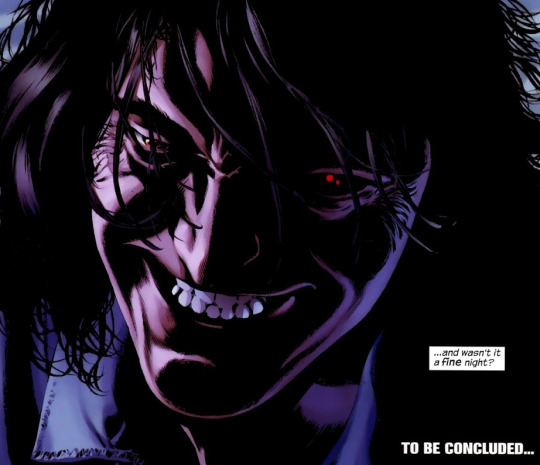
Halloween Havoc rambles on! I decided to read a Stephen King Classic via it’s comic book adaptation from Marvel Knights 4 and Afterlife with Archie scribe and future Riverdale showrunner Roberto Aguirre-Sarcasa. A deadly plauge sweeps across the US that kills in it’s wake while the goverment tries to cover it up. Because that’s not at all terrifingly close to home. But as this pandemic creeps around the US we meet 5 dispearte people with a part to play in what the world becomes after the end: Stu, a hard nosed man who finds himself imprisoned by the government since he was next to patient zero for the outbreak and lived. Frannie, a young woman who finds herself pregnant and dealing with her disaproving mother and the babie’s less than ideal dad. Larry, a would be one hit wonder whose come home to new york to dry out and to let Stephen King go on for several pages about how much he fucking hates new york, because that was important. Nick, a deaf and mute teen drifter who finds himself subbing for a kind sherieff who sadly got the disease. And Lloyd, a dumb criminal who finds himself in jail after a robbery gone bad. And waiting in their dreams and the shadows for his acendency, the walking dude, Randall Flagg, evil itself. Waiting paitently for the soon dawning time of his ascendency. Spoilers and the review itself under the cut.
So yeah i’m back to doing some comics reviews and I.. genuinely missed it. I did. I just needed to reajdust from doing one issue at a time to doing full arcs as well as get it in my head to do one. And while I didn’t INTEND to review these, I ended up liking this series, at least for this mini, so much I couldn’t resist diving into them critically. As for why I decided to read these comics it’s simple: i’ve never read the Stand but always wanted to. No real complex motives: I’ve liked some adaptations of King’s works with It: Chapter One being the reason I finally started watching horror movies after a good decade or two of avoiding them like the plauge, finally breaking down my squeamish cowardly barrier and opening up a greater world. Granted the sequel was a giant balloon parade of disapointment, but I can get to that some other day. Point is I like Stephen King: he seems like a decent enough guy, has had some good adaptations of his works and even the bad ones have some fun. Like this trailer for maximum overdrive where it’ shard to tell if it’s his tragic drug addiction or just him that’s responsibile for that wonderful delivery.
youtube
So yeah, with little options to read the stand and the series out of print, I decided to dive into the comics because they seemed accurate enough from the way reviews had them and frankly before horror films, I really got into horror through comics, with my gateway there being Roberto Aguirre-Sacasa’s afterlife with archie. Many of you may know RAS, as i’m calling him so I don’t horribly mangle his namem, as the guy behind riverdale, sabrina, which is partialy based off his own sabrina comic and kathy keene, but before he became Archie’s golden boy, he was a writer at marvel, hence these mini series, and wrote the wonderful fantastic four series marvel knight’s 4, which I might cover at some point, which followed the four as they lost all their money and had to live like us normal folks. It’s really fucking good stuff and easily one of the best runs on the characters period. Afterlife with Archie is no slouch either so pairing both guys who brought me to the terrordance of horror seemed like a match made in heaven. So that’s where we Stand, pun intended: I haven’t read the stand or watched the mini series, only know or remember some spoilers, and am walking into this blind but eager to see what happens. So if your willing to join me on the ride and on my fresh perspective, here’s Stephen King’s the stand by RAS and Mike Perkins. Now since, at least at this early stage, The stand is divided up by the characters and what their going through as the virus hits, i’m going to cover this character by character, with an additional section on the progress of the pandemic itself and the government response. Before I dig in I will say there is something I really love here: The Pacing. NOw I will grant it’s slow: By the end of this mini we only JUST meet big bad Randall Flag as the pademic and it’s goverment coverup both kick into high gear. So why does it work? Simple: The characters. By opening up as the end of the world is happening instead of shortly before or after like most post apoclayptic stories, and focusing on each of our surivivors we get a real sense of who our heroes were before society collapsed as it collapses, and get to really care about them and WANT to see how they react to the end of the world and what they become. It justifies the series, and the book’s , massive length by using that giant stretch of time to get us invested in the cast and really want to see where this story goes. It’s really good storytelling and holds up really well. So with that out of the way, we can dive into the meat of the story itself. And before we can get to our protaganists, let’s get to the plauge itself
THE OUTBREAK
The story starts with a soldier breaking out of quarantine after getting hit with a miltary virus, infecting his wife and child while trying to go awol and dying.. thus starting the plauge known as Captain Tripps. It crashes into a small town gas station, where we met Stu, one of our heroes, more of him later and starts to slowly grip the nation as the book goes on. The Goverment handles making a plauge that will end up dooming the human race.. by pretending it dosen’t exist, supressing the media, and cordening off whole cities and taking them over. An early attempt by the media to get the story out get the reporters shot horribly, and we get to see all the gore in this version. it’s not plesant but it’s a well done sequence. We get an even worse sequence where the general in charge of the facility captain tripps came from seeing tons of dead bodies in the cafeteria from their sceintests failed attempts at a cure, one of which is horribly bloated, and then shoots himself..... yeah I got nothing. Just.. wow. Good horrible stuff.
So yeah tha’ts basically how it goes: the goverment can’t figure out how to stop it and tries desperatley to cover it up or downplay it instead.. and why yes our own goverment’ sbungled handling of coronavirus, with our own PRESIDENT, in the hospital right now, does make this extra chilling to me thanks for asking! It SOMEHOW gets worse with the final issue as various media outlets rebel against the goverment supression with tv, newspaper and radio all reporting on this despite the risk.. that comes true as the goverment STILL dosen’t learn their lesson and kills them all and we end as the virus only gets worse and the president urges everyone that it’s all fine despite teh mass bodies dumped into the sea and to just take some juice. Just.... just.....
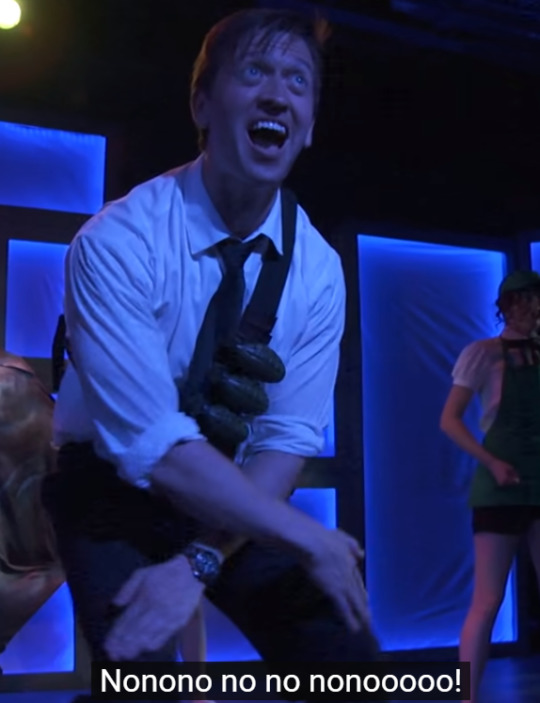
Yes exactly thank you Jon. It’s good stark horrible stuff, I just have no more commentary other than please make it stop. I will say however it’s well done stuff that lets the creeping dread seep in until it really hits fever pitch at the end.

Stu Redman:
As I mentioned, we meet Stu very early on, as he’s on site when patient zero crashes his car into a gas station. Unfortuntely for him this gets him and hsi town swept up to a goverment black site where as seen above, he has no time for the bullshit their feeding him and is in no mood to actually cooperate till they actually talk to them. Which.. yeah it’s entirely resonable: the Goverment is holding him here against his will, refusing to tell him anything and asking to get samples from him. How does he know their not just going to shoot him the second their done with him? He dosen’t and given what we’ve seen this version of the goverment, and hell the real goverment do, yeah. Maybe blind trust needs to be earned rather than demanded. Just saying. Stu gets his answers, that everyone else they brought in and thus his whole town is dead, and they don’t know how to stop the virus.. and that they don’t know where it came from but as the above makes clear, that’s a load of garbage. So Stu relcutantly and grumpliy coperates. He’s basically if Ron Swanson got freaky friday’d into nick millers body.
Stu eventually gets taken to a diffrent facility after the jounalist thing and becomes even more coperative, as they start bringing in an armed guard every time someone visits him.. and Stu starts to get even more wary of this shit as it’s very obvious he’s become expendable, he uses those exact words, and by the end of this mini is plotting his escape. He also has dreams.. of iowa cornfields.. and a sinster man in black floating above them. I like stu a lot: A hard nosed down to earth guy who dosen’t take shit, but is clever enough to know when to bite his tounge and bide his time, easily sussing out both why he’d been moved to a new facility and just how disposable he now is: He’s a man who will fight when needed but knows when to hold back and wait for it. He’s also a nice protaganist ot be our main viewpoint in the goverment sections and is easily my second faviorite. My faviorite is coming shortly.

Frannie Goldsmith:
Frannie is a college student who just ended up pregnant by her boyfriend Jesse. She dosen’t want to marry him despite him offering.. and given his reactions to her telling him this are to whine “but you were supposed to be on the pill”, which she was and gave plenty of reasons why that may not have worked, and then give a loud , what was probably groaning “Aw hell” before proposting.. yeah good call.
Frannie’s dad takes it well as he’s sad, but he understands and loves his daughter and wants to support her. Her mother.. is a selfish nightmare who bearates her for it, berates her husband, who usually backs down as Frannie is used to at this point, for standing up for her and then just for added terrible points physically abuses Frannie, who is PREGNANT, by slapping her hard. I know that can’t hurt the baby but fucking really. Thankfully Frannie’s father decides even if he wont’ divorce the crone to stand up to her at least, and points out she really hasn’t been the same since Frannie’s brother died, igorning her up until the pregnancy and calling her out. She leaves in a huff defeated, and Frannie leaves to go stay at a hotel for a bit while tryign to find somewhere to stay, with her mom not wanting to talk to her and her dad insiting she come around. Given her mother had signs of the virus earlier.. she dosen’t. She dies, Frannie, having come home to help her is devistated and we actually get a devistating if confusing bit as she hugs her dad and talks about eating the pie. Something lost in translation but the visuals cover well enough. And that’s where he story ends, though with a montage in the last issue, which is all we get of htem as the issue is focused on Flagg and the pandemic response instead. Not a bad move mind as it’s easily the best issue of the series, just a note. Frannie is a likeable enough character, a strong woman who knows what she wants, wants to keep her baby and has decent enough family drama.. if well worn at this point but fraknly the book was written all the way back in the late 70′s so this is forgivable as it probably wasn’t AS common as it is now. Frannie has plenty of personality but her plot is one of the less intresting as it’s pretty easy to tell where it’s going in comparison to the other, more intresting plots going on around it. That said you still connect to frannie enough for it to not feel like a drag on the story and to feel important, so it’s not too bad a section.
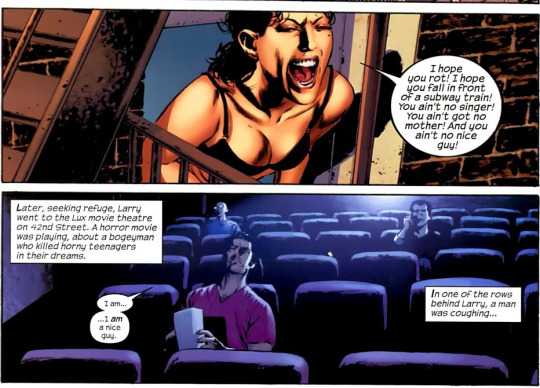
Larry Underwood: Larry Underwood is a musician whose also a bit o fa scumbag, using people and drugs like theres no tommorow and riding high, in both senses, off the sucess of his single.. a title that sums up the 70′s in a nutshell “Baby Can You Dig Your Man?”. Just.. it sounds like a parody song from SCTV... so in other words good job on making a goofy 70′s pop hit title stephen. Respect.
But yeah a friend of Larry’s seeing he’s hit bottom suggets he had back to new york. Larry bunks with his mom who worries it’s too late for him to change from the scumbag he is now and that only a great catstrophe could do that.

So yeah obviously it’s gonna, but we’ll likely see that as the series goes on. So mostly Larry’s segment is one incident of him having a one night stand that seems a bit overblown.. I mean it is scummy of him but her screaming “your not a good guy and what not as seen above just seems narmy as hell and utterly stephen king in terms of writing.. but the scene of him trying to convince himself she’s wrong after is really strong. Larry’s self doubt, self hate and wondering if he’s that bad is really strong stuff and really godo character stuff showing he is an asshole who uses people including his own mom.. but also genuinely DOSEN’T want to be that person but dosen’t know how. We also get a crushing bit where he calls for his friend who helped him only to find out not only is the guy in the hopstial but it’s getting bad. As the chapter ends larry looses his mom too. The one real weakness of this bit is King goes on a bit of an author tract that’s kept via larry’s narration, which by the way I love how the books narration is kept REALLY damn well via the caption boxes, it’s really nicely done and a way to help keep some of the bits from the book while still taking bits out where necessary. It’s a nice touch. But back on point yeah.. Larry REALLY hates new york.. which to me translates as Stephen King REALLY hating new york, and wanting you to know how much he hates new york, how much the city was festering back then, how much of a crap hole it is, how it farts turds during thunder storms etc. IT’s likely trimme down from the text but boy does it feel unecessary> We get it, 70′s pre clean-up intiative new york was REALLY fucking awful. You didn’t like it there. But if you want to rant about new york for several paragraphs..

Like I get that he’s TRYING to make the point Larry dosen’t like new york and dosen’t fit in at home but instead of trying into his character arc entirely it just feels like an excuse for King to ramble about his hatred of new york. I’ts easily the weakest part of this mini series and I only think it was kept because RAS, as made clear in the question and answer sessions with marvel.com in the back of one of the issues, is a huge king fan and wanted to keep as much as possible. It’s the one time I feel the comic, and the story it’s retelling, really stumbled that bad. Thankfully with that rant over we can get onto my faviorite character
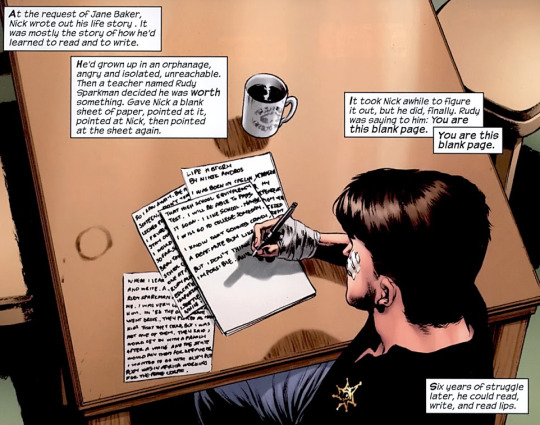
Nick Andros: Nick is easily has both the most unique narriatve and is the most intresting character to me. A mute and deaf teenage drifter, he goes from town to town finding work.. and between towns get beatup by a bunch of local assholes the ringleader of which is your standard Stephen King bully because depending on the kindness of strangers in a stephen king story is just asking for a beating. Though oddly enough that ends up working as Nick finds himself in a jail cell with the local Sheirff and after getting a pad and paper, not only verifies he was working with someone in town, and who he is , but also who beat him down. And oddly for a king story since while he DOES have a heroic sheirff i’ve heard of, most of his law enformcent seem to be corrupt hicks at best, this one.. is a nice guy who makes sure the assholes that assaulted nick are brought in despite the ringleader being his wife’s nephew and knowing he’ll get no sex for a while because of it.. the narrative points this out because we needed to knwo that apparently.
But said wife happily takes Nick in along with the Shierff while the sheirff takes 3/4 of the assholes in, with said nephew booking it out of town. But soon our kindly sheiff takes ill from the virus and Nick gladly fills in for him as his new deputy to make sure the idiots at the jail don’t starve. He continues this throught the book even as he looses his new family tragically due to the virus.. and soon his prisoners catch it too and clearly aren’t long for the world. Nick is a THROUGHly likeable character. Just from body laungage it’s clear there’s a bit of an edge and a bit of harshness to him.. but he’s mostly just a good kid who goes out of his way to make sure three assholes who tried beating him to death get fed and watered, and wants to do the right thing despite the world crappign on him constnatly. He’s throughly intresting and his disablity is nicely portrayed, with him being portrayed as a normal guy who simplyg ot dealt a really crappy hand and does his best with it. Easily the best part of this mini, closely followed by the last issue but we’ll get to that in a second. We have one more character to get through.
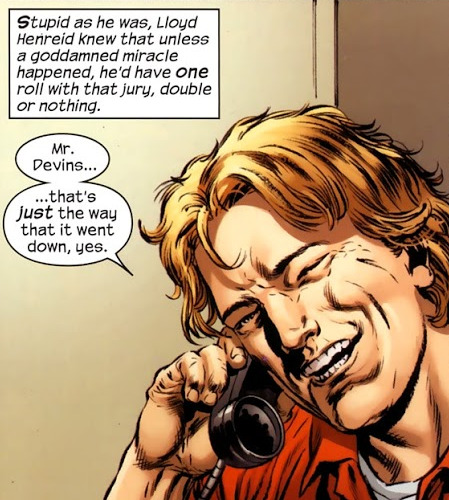
Lloyd Henried This bit will go fast since he’s only in two sections this mini but Lloyd is a dimwitted crminal who clearly gets a thrill from the crime sprees and murders he and his pal have done but also dosen’t murder inscreimatley. Unfortunatley his partner in crime does and Lloyd gets arrested after his first scene and hsi friend gets his face gunned off. Lloyd is last scene with his lawyer teaching him to lie. He’s basically just a dumb criminal at this point who likes thrills. Not a lot to dig into comapred to the other characters soooooo let’s move on to our final focus character and the focus of the final issue only, but hitned at before...

Randall Flagg The breakout character of the piece, one of king’s most loved and most used villians. The Walking Dude. The Devil HImself. I had high expecations of this character with all that hype and he did NOT disapoint.
Flagg is a mysterious supernatural drifter who dosen’t even know how long he’s existed but is evil itself. He makes anyone he passes feel nervous, glass crack and everyone uneasy, yet when needed can slip in and out of any extremist or hate group easily and hands out pamphliets for whatever will get people riled up the most, good cause or bad. and easily worms his way in and out of heavily armed groups and into women’s beds. My words do not do kings words put onto the final issue justice. They jsut impart he is evil, he is here, and he is about to RISE. And you’d better be prepared to run. After a few issues of only appearing in one dream.. we meet our antagonist and he is a lot. Throughly engaging, throughly creepy and throughly unesettling we get a full sense of who flagg is a drifter who SEEMS resonable enough when talking but just.. gets under your skin, yhou just feel.. WRONG around him. This one sequence REALLY got me excited to see what this bastard does. Not a lot elsse to say throughly engaging creepy impressive villian who lived up to the hype and star of one of the best single issues i’ve read. No notes.
So yeah overall.. I really love this story so far. Obviously I have a LONNNG way to go and 5 more mini series to go so I hope you’ll join me but the art is good, the decisions fantastic and the writing adapted well, clearly compressed but in a way that works. A fantastic way to read the story for a newcomer such as myself and if you can find it somehwer,e read it. Ill continue with it as hte month, or months probably, go on. Until then check back on my blog for regular ducktales coverage and some more halloween fun, hit up my asks if you have some comics you’d like to see me cover, and until next time, happy halloween.
#halloween#halloween havoc#the stand#stephen king#randall flagg#horror#marvel comics#roberto aguirre-sacasa#mike perkins#stu redman#nick andros#frannie goldsmith#larry underwood#comic books
4 notes
·
View notes
Text
Dom’s mini Who reviews - the best episodes
Amy’s Choice – This proves how a strong concept trumps big budget spectacle every time. Character development is key here and Amy is at the centre, her dilemma distilled into the titular decision. Add to that one of the weirder alien designs, a hell of a cold open and a guest performance from my favourite actor of all time, Toby Jones, and you’ve got one of the highlights of series 5.
Bad Wolf/ The Parting Of The Ways – This is my favourite story of the whole show, packed with more iconic moments than I can list. 9 completes a character arc that was skilfully woven throughout his tenure while Rose & Captain Jack both get to shine in their own ways. Some people don’t like the game shows in Bad Wolf but I think they’re really unnerving in a Black Mirror way. The Daleks are just as threatening as they were earlier in the series and I cheer when the Emperor gets his comeuppance.
A Christmas Carol – Dickens finally done justice! The steampunk Victorian aesthetic is cool without detracting from the story and the fog imagery is stunning. Obviously Michael Gambon makes a wonderful Scrooge and Smith does well to keep pace. But the real wonder is the screenplay which cleverly plays on the time travel elements inherent in the original novel. Magical!
Dalek – This one is hardcore as hell. In the scene when the Doctor first encounters the Dalek, Eccleston gives one of the best performances of the whole show. The bunker setting creates a tense, claustrophobic atmosphere and it’s horrifying to see the Dalek pursuing Rose through its corridors. The Doctor’s PTSD is front and centre and there’s a real sense that he’s grown by the end.
The Empty Child/ The Doctor Dances – Scary as all hell, but Moffat balances this with plenty of rom com humour. Cpt. Jack makes his charming debut and Nancy is compelling (when she’s not saving the day by threatening to out a closet homosexual). And of course, the ‘everybody lives’ scene is lovely. 9 has more of an arc in one series than 11 does in three.
Face The Raven – Firstly this looks gorgeous. The Diagon Alley inspired setting is darkly beautiful, enhanced by the warm lighting. Clara’s series arc neatly concludes with her accepting the consequences of her mistake and Capaldi and Coleman do some of their best work in the final scene. Get past the plot holes around who can and can’t remove the chrono-lock and you’ll love this one.
Heaven Sent – Bloody hell. Moffat finally gives Capaldi a format where it makes sense for 12 to endlessly monologue. The Veil is pure nightmare fuel and the TARDIS scenes are really inventive. But of course the highlight is the final sequence where direction, acting, music and most of all, editing come together to make it feel like you’ve really been there 4.5 billion years. In a good way.
Human Nature/ The Family Of Blood – Paul Cornell gives us another story where an ordinary man has to sacrifice himself to save the world, this time in a better setting with better villians. Harry Lloyd and the other Family members all seem like genuinely evil aliens. Martha is better served here than in most of Series 3 and Tennant & Hynes sell the romance. The ending’s a bit ‘Return of the King’ but the music’s lovely.
Midnight – Davies beats Moffat at his own game; there’s nothing scarier than what you can’t see. I always come away from this with a sense of unease normally only Black Mirror can give me. It’s essentially a play and so the script and ensemble cast are a cut above the average episode. I like that the show tends to optimism but sometimes it’s important to show the worst of humanity too.
Smith & Jones – Up there with ‘Eleventh Hour’ for best series opener, only this is better paced. The hospital’s kinda boring but then wtf we’re on the bloody moon?! We get a nice concise introduction to Martha and her family in the first 60 seconds then it’s on with the action! Up and down stairs and corridors it’s non-stop, no shoes, action until the magical alleyway scene caps things off nicely.
Turn Left – Every show should have a sliding doors episode. Catherine Tate proves she’s more than just a funny face while Cribbons and King step up into more prominent supporting roles. The episode takes fun references to previous stories before making them horrific. The scene with the Italian family is particularly bleak. Then the final act brings back hope, time travel and Rose Tyler.
Vincent & The Doctor – Sometimes a slow pace is better suited to a certain story. We get beautiful location filming and a sensitive exploration of depression that really tugs the heartstrings. Tony Curran gives the best portrayal of a historical figure of the whole show and the final gallery scene is an unexpected delight, cheesy rock song and all.
Voyage Of The Damned – Director James Strong shines again in the closest Who has come to an action blockbuster. Davies takes time to get you invested in the supporting cast before cruelly killing most of them off. Kylie Minogue does a decent acting job for a pop star. Max Capricorn might be a bit silly but his plan is so flipping evil that it’s a relief when he gets his comeuppance.
The Waters Of Mars – This takes a little time to warm up but once the horrifying monsters show up, this is pure gold. In some ways this is a re-tread of The Fires Of Pompeii, only now the Doctor has learned the wrong lesson and crosses a big ethical line. The ‘Timelord victorious’ scene is one of Tennant’s best moments and Lindsey Duncan brings a fresh antagonism to the companion role.
#amy's choice#bad wolf#parting of the ways#a Christmas carol#dalek#the empty child#the doctor dances#face the raven#heaven sent#human nature#the family of blood#midnight#smith and jones#turn left#Vincent and the doctor#voyage of the damned#the waters of mars#Russell t davies#steven moffat#Robert shearman#sarah dollard#paul cornell#Richard curtis#matt smith#david tennant#Christopher eccleston#peter capaldi#doctor who#my post#doctor who ranking
7 notes
·
View notes
Text
Jerry Lewis. No comedian since Charles Chaplin has been so loved and so reviled. He is America’s Dark Prince of Comedy--brilliant, bitter, passionate and deeply conflicted. A man of many demons, his cockiness conceals a labyrinth of doubts and self-destructive impulses. An American original whom Americans have never quite come to terms with, he also happens to be one of the greatest filmmakers of the latter half of the 20th century. And for this he deserves an Academy Award.

It’s not surprising that he’s never even been nominated for one. The Academy of Motion Picture Arts and Sciences has a tradition of snubbing comedians. The list of those whose movies failed to win a single Oscar is appallingly long and distinguished: Buster Keaton, Harold Lloyd, Harry Langdon, Mabel Normand, the Marx Brothers, W.C. Fields, Abbott and Costello, Bob Hope, Red Skelton, Lucille Ball, Bill Cosby, Richard Pryor, to name a few. The academy finally gave Keaton an honorary Oscar in 1960, and one to Stan Laurel in 1961 (after Lewis lobbied passionately on his behalf), and even one to Charlie Chaplin in 1972, bringing the once-demonized “un-American” director back to Hollywood after 20 years of exile in Europe.
Now it’s time to honor Jerry Lewis.
Lewis was a superstar in the 1950s and early ‘60s, the I Like Ike era of “The Organization Man,” when a Wonder Bread corporate monoculture force-fed an entire generation a bland diet of conformity. In a time of crew cuts and bouffant hairdos, of TV dinners, suburban tract houses, gleaming new supermarkets and the homogenized nuclear family paradigm set forth by “Father Knows Best” and “Leave It to Beaver,” Lewis’ archetypal character, “the Kid,” served as an escape valve--a personification of the American id, cavorting across TV and movie screens, acting on the anarchistic impulses his audiences felt obliged to repress.
“We used to hang out on street corners, and guys would do Jerry Lewis imitations,” says Philip Kaufman, director of “The Right Stuff” and “The Unbearable Lightness of Being,” who came of age in the 1950s. “The way that Jerry Lewis walked, that staggering, uncoordinated adolescent walk--you could feel the American youth culture being born. . . . Lewis and Elvis had this primordial American energy.”
Lewis gradually filled his comic archetype with nuances and complexities, so that it continued to resonate on deeper and yet deeper levels. He did this by becoming what he calls “a total filmmaker,” as Chaplin and Keaton had been. When Lewis began appearing in movies in 1949, he set about learning the technical intricacies of every aspect of production. “After about a year and a half I was able to load a BNC [35mm Mitchell] camera and do anything on the set that any technician did--maybe not with the quality of a man who’s done it for 25 years, but if he got sick, I could do it,” Lewis told me in an interview in December 2003. “I know depth of field like you know your wife’s first name. . . . I therefore proceeded to own every union card in the picture business.” Along the way, he also managed to invent the video assist, which allowed him to instantly replay scenes he’d just shot--now standard equipment on most Hollywood sets.
Once he’d mastered the filmmaking process, Lewis dared to declare his independence from the studio system. He wrote, directed and starred in a series of features that he also co-financed with his own money. “I mortgaged my house a couple of times, sold two cars, I remember that!” Lewis told me. In exchange for putting up half or sometimes the entire budgets of the films he directed, he got 50% or more of the profits and a level of creative autonomy that no screen comedian had commanded since Chaplin. “I had final cut on everything,” he said.
“I would love to have achieved the level of independence that he had,” Kaufman says. “The opposite is Orson Welles. He’s a half a generation before Jerry Lewis, but he gets destroyed because he can’t control the films.”
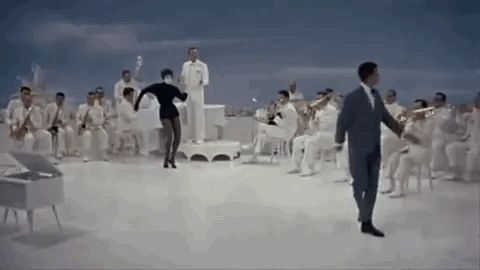
The movies Lewis directed--including “The Bellboy” (1960), “The Ladies Man” (1961), “The Errand Boy” (1961), “The Nutty Professor” (1963) and “The Patsy” (1964)--were bizarre stream-of-consciousness concoctions packed with brilliant pantomime set pieces and surreal comic nightmare sequences, moving Rorschach inkblots that reflected Lewis’ deeply conflicted psyche. “They were not regular Hollywood films,” says director Martin Scorsese. “There were no stories. No plots. They were very dreamlike, going from one free association to the next, almost like the later Luis Bunuel pictures, like ‘The Phantom of Liberty,’ which was a dream within a dream within a dream. You know you’re in the hands of a master; you just let him take you along. His films were almost avant-garde.”
Like Buster Keaton, Scorsese says, Lewis had an uncanny ability to pour his subconscious onto a movie screen, creating phantasmagoric visions permeated with disturbing psychological undertones. Unlike Keaton, Lewis often worked in color. He urged his cinematographer, W. Wallace Kelley, to pump huge amounts of light onto his sets until the comic book hues popped off the screen. “Lewis’ use of color has influenced many filmmakers, [such as] the way David Lynch uses color, and Pedro Almodovar,” Scorsese says.

In the mid-'60s, European critics--the French, most famously, or infamously, depending on your point of view--embraced Lewis as a genius, an heir to Chaplin and Keaton. Chagrined American critics sputtered outrage. They saw Lewis as a vulgarian, a pretentious, sentimental egomaniac who was a tad less subtle than the Three Stooges, and a lot less funny. And those were the good reviews. “Mr. Lewis is a frenetic performer,” wrote Eugene Archer of the New York Times, “but he lacks a point . . . a rubber-limbed robot making faces in a void.” Harriet Van Horne of the World Telegram wrote of a Lewis performance, “you flinch from the soulless vulgarity of his spastic twitches and low-class leers.” In his 1968 book “The American Cinema,” Andrew Sarris demeaned not only Lewis, but also his fans. “Lewis appeals to unsophisticated audiences in the sticks and to ungenteel audiences in the urban slums,” Sarris wrote. “He is bigger on 42nd Street, for example, than anyplace else in the city.”
Lewis seemed to scuttle any chance that American intellectuals would change their minds by taking the fight to the enemy. He wrote nasty letters to reviewers and denounced them on television and radio. He said they were “caustic, rude, unkind and sinister. . . . They’re burying the business they’re paid by.” And in his most infamous salvo, blasted in a 1981 Los Angeles Times interview, he called them “whores.”
But beneath his belligerence one sensed the man had been deeply wounded. In a telling passage in his landmark 1971 book about moviemaking, “The Total Film-maker,” Lewis confessed: “I cannot sit at certain tables at the Directors Guild because I make what some people consider is a ‘hokey’ product. John Frankenheimer waves and hopes that no one else sees his hand, simply because I film pratfalls and spritz water and throw pies.”
In countless magazine profiles and biographies, Lewis has been vividly portrayed as a tantrum-throwing egomaniac. But there is another side. I’ve talked with many people who worked with Lewis over the years--including his longtime collaborators, writer Bill Richmond and comedienne Kathleen Freeman--who told me stories of his private acts of extraordinary kindness and generosity. Peter Bogdanovich tells of how Lewis befriended him when he was a poor, young aspiring filmmaker--lending him a car, allowing him to screen movies at Paramount and charge the cost to Lewis’ production company. “He’s been a good friend to me for more than 40 years,” Bogdanovich says. When I first interviewed Lewis a year ago, I found him to be a perceptive, articulate but deeply divided man who oscillated during the course of our one-hour conversation from laughter to anger to tears. His ability to infuse his movies with these seething emotions gave them their strange emotional charge, and helped make them audacious and poetic works of art.
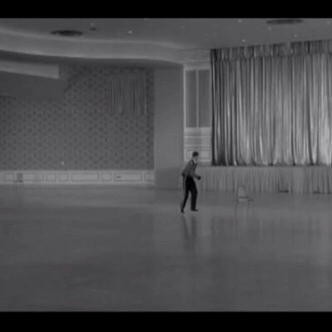
In “The Bellboy” and “The Errand Boy,” Lewis’ Kid finds himself wandering through sprawling corporate complexes: the ultramodern curvilinear interiors of Miami Beach’s Fontainebleau hotel, and the cavernous soundstages and maze-like streets and corridors of a movie studio. He desperately tries to mesh with the gears of the industrial combine, but his inability to function with the automaton efficiency of his co-workers inevitably causes catastrophe. “There’s a sense in which he’s a modern man, a universal figure confronted with modernity, with bosses and difficult jobs, and especially with a fast pace that’s difficult to keep up with,” says Henry Sheehan, critic for KPCC-FM and KCET.
There are haunting moments that evoke the lonely yearnings of the alienated in America’s increasingly institutionalized society, such as the brilliant pantomimes in which the Kid conducts an imaginary orchestra or imagines himself to be a movie mogul holding forth in a deserted boardroom. Or the scene where the Kid is assigned the Sisyphean task of setting up more than 1,000 chairs in an auditorium the size of a football field. Lewis films from one wide angle, holding the shot as the Kid recedes farther and farther into the great hollow hall. “When he started directing his own pictures there was a powerful visual sense,” Scorsese says. “It was almost as if the films were drawn by hand--animated. Something was very arresting about the way Lewis designed his scenes and shot them, the way he focused the eye of the audience.”

In the middle of “The Bellboy,” the Kid is ordered to help with the luggage of an arriving celebrity: Jerry Lewis, the movie star. Lewis the star arrives in a limousine with a huge retinue of yes-men and sycophants. “That kind of thing was refreshing and brilliant,” Scorsese says. “It opened the audience’s mind. What is the reality? We know we’re watching a film. We know it’s directed by him. We know he’s in control. Then he shows up as a film star within the movie! It plays with your sense of what reality is and what cinema is--and also what celebrity is.” In a culture obsessed with celebrity, Lewis shows us that a star is as objectified as a Playboy centerfold, and his existence at the top of the ladder every bit as lonely as that of the Kid at the bottom. The entourage of Jerry Lewis the movie star laughs at his every remark. When he tearfully reveals that a beloved aunt just died, the crowd howls with unhinged hilarity. “Nothing like a laugh!” someone screams.
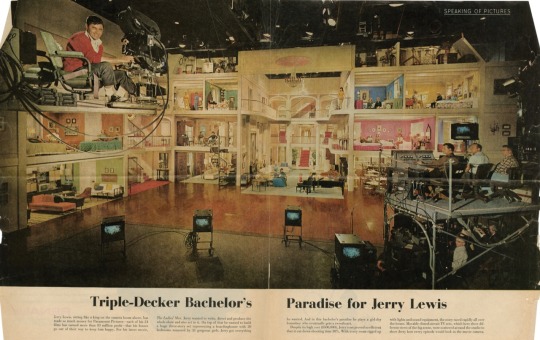
In “The Ladies Man,” the Kid serves as a gofer in a boarding house full of young women. Lewis built the entire mansion--four stories tall, including a stairway and working elevator--on two soundstages at Paramount, with the fourth wall of every room cut away, like a giant dollhouse, so the camera could swoop on a crane from room to room, each of which was pre-lighted and wired for sound. It was another groundbreaking technical innovation, and a fantastic dreamscape through which Lewis’ imagination ran wild. In one spectacular crane shot, Lewis pulls back to show the entire dollhouse. “That shot is so striking,” Scorsese says. “In a funny way, it had something to do with the way I did a shot in ‘Gangs of New York’ in the beginning of the film, showing the [multileveled] hell of the old brewery
Scorsese found more inspiration in Lewis’ masterpiece, “The Nutty Professor,” in the famous sequence that occurs after Professor Kelp has transformed himself into the incandescent lounge lizard Buddy Love. At first we do not see Love. Instead we see the world through his eyes. In an intricately choreographed tracking shot, Love walks through the street toward the Purple Pit nightclub and various passersby react with astonishment to his high-voltage charisma. “I use that as an example of the kind of point-of-view shots that I use,” Scorsese says. In “Gangs of New York,” he told his assistant director, Joseph Reidy, that he wanted to choreograph a similar point-of-view shot in the scene where Amsterdam Vallon (Leonardo DiCaprio) places a rabbit pelt on a Five Points fence as a declaration of war. “I am constantly referring back to Lewis’ work,” Scorsese says.
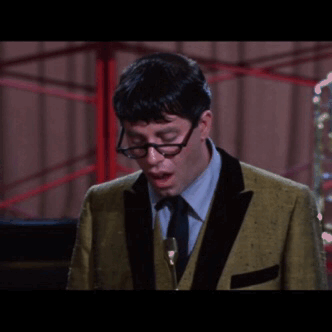
Lewis explored the polarities of his personality--the lonely kid he had been in his youth and still felt himself to be, and the polished persona he presented on television and in live performances--not only in “The Bellboy,” but also in “Cinderfella” (directed by Frank Tashlin and produced by Lewis) and “The Errand Boy.” This theme reached its full and most complex expression in “The Nutty Professor.” The movie is an extended investigation of Lewis the public performer, and his insecure inner self. But more than a movie star’s exercise in self-absorption, it is a meditation on the American model of masculinity. Lewis acknowledges its pathology even as he admits that he cannot free himself of his aspiration to embody it. In the climax of the movie, Buddy Love transforms back into Professor Kelp before a stunned crowd of college students. Kelp makes a heartfelt speech about the fallacy of trying to create a false personality to please others and the need for self-acceptance, and there’s not a dry eye in the house. But in the film’s denouement, as Kelp leaves for his wedding with heartthrob Stella (Stella Stevens), the director reveals that she has stuffed two bottles of Kelp’s magic tonic in the pockets of her jeans--an admission that there’s a dark, erotic power to Love’s aggressive posturing that Americans find irresistible, despite whatever lip service they may pay to the values of sensitivity and brains.
“Lewis’ sense of burlesque is a strange type of comedy because it’s full of anxiety,” says director Barbet Schroeder (“Barfly,” “Single White Female”). “It’s a tragic vision that makes you laugh. . . . And all that is completely personal and completely extraordinary. He took burlesque comedy one step further, like any great artist, to a very freaky, disturbing modern tone.”
In 1977, someone at an American Film Institute seminar asked Lewis why his films hadn’t been rediscovered, as those of other great comics had been. “They wait until you die,” he snapped. Until recently, it looked as if Lewis might be right. During the last decade, a series of serious health problems--bouts of meningitis and pulmonary fibrosis--forced him to cancel live engagements and spend long stretches in the hospital. But last year, Lewis bounced back. He returned home from the hospital, and in the fall he released sparkling wide-screen DVD transfers of 10 movies from his golden period, complete with outtakes and commentary tracks.
And the damnedest thing happened. They got good reviews. The New York Times published not one but two rave notices. In the second one, Dave Kehr wrote: “Is it finally time to stop with the French-love-him jokes and acknowledge that Jerry Lewis is one of the great American filmmakers?” Kehr noted that the DVDs “reveal both the fierce creativity of his comic performances and the extreme formal sophistication of his direction. The centerpiece is the 1963 ‘The Nutty Professor’ . . . a study in split personality that both anticipates Ingmar Bergman’s 1966 ‘Persona’ and surpasses it in psychological acuity. It’s also a lot funnier.”
In December 2004, the Library of Congress concluded that “The Nutty Professor” is a movie of lasting cultural significance, worthy of preservation, and added it to the National Film Registry. Then in January, Lewis received a career achievement award from the Los Angeles Film Critics Assn. The explanation for this turnaround is simple: As older critics retired, a new generation replaced them. They had come of age in the 1950s and ‘60s and had spent the better part of their youth in the dark, watching Jerry Lewis and laughing till they just about wet their pants. “For me, personally, the impact of watching ‘The Nutty Professor’ as a boy in a drive-in in the Valley was huge,” says Robert Koehler, who writes for Variety. “It was the first time I had felt a weird sense of terror, horror and comedy all in one fell swoop. I’d never felt that before in a movie. There was something going on here besides just another Hollywood comedy. There was a sense of wild theatrics. I was only 7 years old at the time; I couldn’t even put my finger on it, but it so absolutely impressed my young mind.”
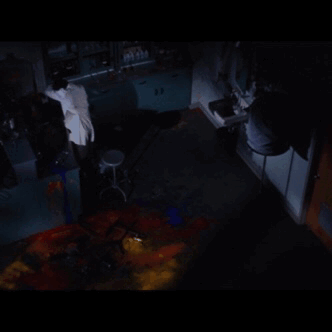
As they grew older, like Morty S. Tashman in “The Errand Boy,” these young fans made their way to Hollywood to become part of show business. Their film school professors and older critics had told them Lewis was vulgar and tasteless, but they went back and watched the movies and didn’t believe it. “I always thought he was funny, from the first time I came to him, at 9 years old,” says Henry Sheehan, president of the L.A. critics association. “Once I grew older and learned something about composition and the mechanics of gags, I was full of admiration for him. I think my experience is pretty common for people my age.”
For years a growing number of Lewis supporters had been urging the association to give the comedian the career achievement award. This year the membership suddenly agreed. “It was pretty widely supported,” Koehler says. “In the past there have been complaints. The first year I was in the group, his name was brought up and some people were openly contemptuous. I heard none of that this time. I don’t know why. I think it’s the test of time.”
As the night of the awards ceremony approached, a question loomed: How would Lewis react? Would he be able to drop the contentious attitude he’d held against his old adversaries for more than half a century? When I talked with him shortly after the award had been announced, he seemed to be struggling for his equilibrium. “I don’t really know how I’m going to deal with it,” he admitted, then murmured something about handling it with grace. But when he talked with other journalists, some of the old fighting verbiage crept into his remarks. He told Larry King the award was “the best revenge I’ve ever had.” And to a reporter from the Los Angeles Daily News, he said, “Jesus Christ, is that retribution or not?”
Finally, the moment came. Peter Bogdanovich presented the plaque. Lewis stepped to the podium. His eyes passed over the crowd. “Thank you very much, ladies and gentlemen. I am delighted to be the recipient of this award. . . . What took so goddamned long?” The room exploded with laughter. Lewis segued smoothly into his Vegas act and did about 10 minutes that had the critics, filmmakers and stars doubled over and gasping for air.
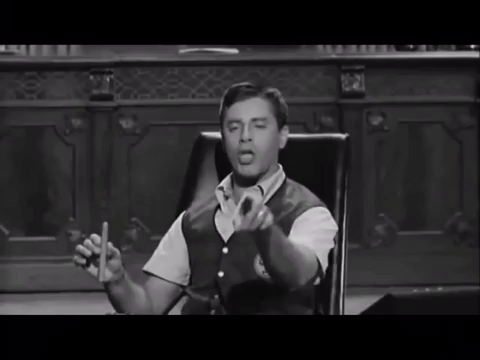
Then he stopped, his voice growing serious. “I would feel somewhat remiss if I didn’t show you something that I believe brought me here tonight,” he said. Film rolled, and on the screen behind him appeared a 35-year-old Jerry Lewis doing the famous Chairman of the Board pantomime from “The Errand Boy,” his gesticulations and mugging timed to the tempo of Count Basie’s “Blues in Hoss’ Flat.” It was much more than funny. It was at once melancholy, poetic and exhilarating. When it was over, the room rose in a howling, hooting standing ovation. The only one of the night.
Now it’s the academy’s turn to step up. A few months ago, Bogdanovich wrote a letter to its president, Frank Pierson, suggesting that Lewis be given an Oscar. I hope the Academy doesn’t take too long. The hour is late. Another great clown and groundbreaking filmmaker, too long ignored, deserves to be honored by his peers.
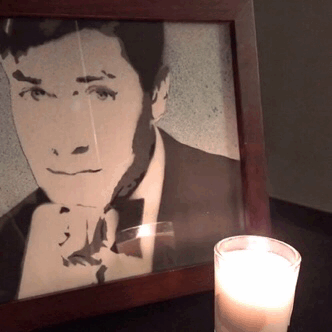
JL’s yahrzeit
The once and future King of Comedy 👑
#rip#jerry lewis#the once and future king of comedy#yahrzeit#LA Times#david weddle#jerry lewis deserves an oscar#king of comedy#quote
67 notes
·
View notes
Photo


NOS4A2 (July 2019)
In the scene, Manx travels to a bar called Parnassus for some advice. Though it initially seems like this bar is real, it becomes clear that this is actually most likely the Inscape — short for inner landscape, a dimension created in the mind — of Abe (Reg Rogers), a steampunk-esque dude who runs the bar. Parnassus is a gathering place for some of the darker elements of the world, creatures/people who use their Inscapes for bad, instead of good (like Vic).
…and though it’s pretty clear that Manx is the baddest of the bad, as his mere presence makes everyone else clear out immediately, the venue is packed full of horror icons. Most of which I, uh, could not identify. To be honest. I tried! I’m sorry! That said, here’s who I did notice:
Pennywise: This is the most obvious one, a clown with a red balloon prominently featured at the bar. That’s Pennywise, from Stephen King’s “IT” and the recent hit movies. And in fact, this isn’t the first time the show has referenced one of NOS4A2 writer Joe Hill’s father’s most famous creations. Back in the first episode, Pennywise’s Circus was referenced on Charlie Manx’s map of Inscapes, roughly around where Derry is in King’s book. And if the idea of Pennywise and Manx exchanging tips doesn’t send a shiver up your spine, I don’t know what would. That isn’t the only King character in the bar, though…
Lloyd: Who else would be tending bar other than the Overlook Hotel’s creepy bartender, Lloyd? Played by Joe Turkel in Stanley Kubrick’s classic movie The Shining, the Lloyd here is sporting the same suit as his cinematic counterpart — though he does look a little younger. And it makes sense to incorporate Overlook into the Inscape universe, as most of that seems to be happening at least partially in Jack Torrance’s mind, as well.
Freddy Krueger: Hey, if you’re going to have a bar full of child-murderers who can enter dreamscapes, why wouldn’t you invite the star of the Nightmare on Elm Street series? This is a decidedly pre-burning Krueger, but he is sporting the iconic sweater, and holding a teddy bear; though he doesn’t have his claw gloves on, so grain of salt there. Krueger is neither from Hill or King’s work, but it’s a natural fit nonetheless.
The final few, I had a little trouble identifying. There’s a character identified as “Steampunk” in the credits, played by New York actress Sarah Boatright. That seems to be the green-haired woman spotted as Manx is entering, wearing a leather outfit and sporting big hoop rings in her ears. She’s opposite a man in a black suit who looks to only have one arm, who I initially thought might be The Tall Man (Angus Scrimm) from the Phantasm movies, which also deal with nightmare type scenarios, but the man here is too young, and The Tall Man has both his arms.
Also going by quickly, a shadowy woman drinking with Krueger wearing a cable-knit sweater and blonde hair, who could be Carrie’s Mom Margaret (Piper Laurie), though that doesn’t exactly track with the whole Inscape thing? There’s also a man who seems to have a gun or something else sticking out of his back, and a woman with a gold mask who gets up before Pennywise. It’s clear that they’re either literary or filmic references, and most likely have access to dreamscapes like the other characters. But I’m drawing a blank, sorry folks.
Regardless, it’s a neat sequence, and one that again opens up a world of possibilities for the show. Where the book was very focused on a few Strong Creatives, the series is adding details that could keep the show going far beyond the initial conflict between Vic and Charlie. At the very least, we need to see much more of Parnassus (though drink there at your own peril).
Source: Decider
(images via YouTube)
4 notes
·
View notes
Text
Ninjago S10 Ep 01 review
This is gonna be spoiler ridden so yeah... blacklist all the tags you feel you must...
I’m gonna give it a try to reviewing each episode “in real time” as I watch it (from the point of view of an extremely obsessive Garmadon fangirl cause yeah... this season is gonna have lots of Garmadon goodness! yaaaas!)
we spared no expense!!!! -- LMAO jurassic park reference! xD
total magneto vibes with that prison omggg
Garm's voice.... he doesn't sound like Garm... maybe because he's not screaming angstily?
OMG HE'S GONNA HELP LLOYD!?!?!?! I KNEW IT
THE OPENING IS FUCKIN SIIIIIICK!!! AAAAAAAAA
That digger looks pretty cool
Omg the city rebuild the Bounty to give to the ninja!!! *cries*
Lmaoo the "would you be my yang" sequence! Plasmashippers rejoyce xD
Lol of course Dareth won't tell anybody xD
AAAAAAAA MAMA DRAGON IS BAAAACK!!!!
AND SHE IS HURT! WHO DARE HURT MY BABY
OMG FAITH IS HERE TOO O____O!!!
Winter is coming... I MEAN, darkness is coming!!! gaaaaah
omg we are already more than halfway into the episode!?!?! i don't want it to end so soon!
gaaah are the oni gonna come through some portal thingie on Borg tower!?!
omg they are hereee!!! Hella creepy
lol classic elevator scene xD
gaaah those oni are the stuff nightmares are made of!! (i love it!)
AAAAAA COLEEEE
Lloyd literally cut through shadow?
"Maybe we can't fight it... but i know someone who can.." OOOOOOHHHH YEAAAAAH GARMADADDY TO THE RESCUE!!! <3333
"You need me" -- HMMMM YESSSSSS
yyyyyyyyyyaaaaaaaaaSSSSSS THE EMPEROR IS FREEEEEEEEEE!!!! AAAAAAAAA!!!!!

#ninjago season 10 spoilers#ninjago season 10#ns10 spoilers#ns10#ninjago s10 spoilers#ninjago s10#march of the oni spoilers#march of the oni#emperor garmadon#lord garmadon#yaaass give me more garm#spoilers#dinogaby stuff#dinogaby rants
10 notes
·
View notes
Text
Pulp Fiction: Realism vs Fantasy in BBC Sherlock
“Pulp fiction” refers to the 19th and 20th century practice of printing lurid, sensational stories on cheap, dingy paper made from wood pulp. Like the magazines themselves, the stories were designed to be highly consumable and disposable.
Doyle’s Sherlock Holmes stories were technically not pulp because The Strand was a glossy magazine. Nevertheless, there was a certain sensationalism and disposableness to these stories of murder, mayhem, and crime.
BBC Sherlock, on the other hand, is “prestige-television”, and yet it is very self-aware about its origins in the worlds spawned by pulp fiction. It plays with this idea repeatedly, forcing the lurid melodrama of pulp storytelling up against the prestige drama’s expectations that stories be rooted in a human-scaled world of believable, recognizable situations and emotions.

JOHN: In real life. There are no arch-enemies in real life. Doesn’t happen. SHERLOCK: Doesn’t it? Sounds a bit dull.
In the beginning, Sherlock appears as a larger-than-life character, or at least as someone who wishes to be seen that way. John pushes back against this, suggesting that Sherlock’s worldview is an impossible fantasy.
Similarly in TBB, Sherlock’s glamorously choreographed fight with a cartoonish baddie is cross-cut with John exchanging sharp words with a chip and pin machine.
Mycroft is a somewhat different case, because publicly he presents himself as a paragon of mundanity. There’s nothing overtly pulpy about occupying a minor position in the British government. And yet, we see over and over that he can’t resist a touch of spy-drama: kidnappings, abandoned parking garages, dead people on a plane…

MYCROFT: He does love to be dramatic. JOHN: Well, thank God you’re above all that.
Here again, John neatly skewers Mycroft’s dramatic inclinations as out of step with the ordinary world John believes they inhabit.
As the show progresses, the narrative maintains this precarious balancing act, repeatedly puncturing its own gestures toward pulp sensationalism. In THoB, the demonically-possessed hound that Henry fears turns out to be a beloved pet dog. The skeleton of Jack the Ripper turns out to be a modern hoax. Sherlock tells us that he “can never resist a touch of drama”, and in TAB, MindPalace!Moriarty takes him to task for this:

MORIARTY: I mean, come on, be serious. Costumes, the gong. Speaking as a criminal mastermind, we don’t really have gongs, or special outfits.
One of the most interesting instances of the writers’ playfulness on this subject is the introduction of Sherlock’s parents in S3. Thanks to certain lurid hints and implications, much of fandom decided early on that the Holmes brothers must come from a recognizably Gothic, storybook background: ancient and infinite wealth, a crumbling estate, eccentric relatives, dark family secrets… But when the parents were introduced in TEH, the characters as written seemed calculated to undercut this pulpy fantasy. Even John was shocked at how ordinary they were, with their reading glasses, lottery tickets, throw pillows, and penchant for Andrew Lloyd Weber.

Here was yet another place where Sherlock and Mycroft’s taste for flashy genre tropes was set at odds to the more prosaic reality they inhabit.
So then, what happened in TFP? In TFP, this initial reversal of expectation gets reversed once again. Instead of the embarrassingly ordinary background we learned about in S3, we get every overheated Gothic trope we could have hoped for: the abandoned family manse, the child murdered under mysterious circumstances, and of course the mad sister left to languish in a secret asylum controlled by her domineering brother. Anne Radcliffe and Monk Lewis could hardly have imagined anything more lurid. Did Moftiss abandon their tradition of undermining these well-worn cliches, and decide to embrace them for once?
Two elements of TFP suggest to me that this is not the case. First is the brief but significant mention of the “funny” gravestones at Musgrave.

MYCROFT: They weren’t real. The dates were all wrong. An architectural joke which fascinated Sherlock.
Mycroft refers to Musgrave as their “ancestral home”, but if the Holmes family were really old-money aristocracy out of a Gothic novel, they would have *real* gravestones on their property, memorializing their *actual* ancestors. The fact that they have this pretend graveyard suggests that the whole family has always been playing at inhabiting these literary tropes.
The other is the opening with Mycroft’s nightmare scenario of evil clowns, sinister children, and bleeding paintings, which turns out to be a nothing more than a cruel practical joke. This sequence clearly parallels the “experiment” Sherlock, Mycroft, and John are subjected to once they get to Sherrinford. As cruel and deadly as Eurus’s games are, they share a family resemblance with Sherlock’s own ethically dubious experiments, games, and jokes:



In each case, Sherlock is using an artificial environment to elicit extreme emotions from an unwilling subject – much the same as what Eurus eventually does to him.
Eurus, then, illustrates profoundly what the audience was previously willing to ignore: the real horror of childish games of storybook-cruelty enacted by brilliant adults who never quite grew up.
TFP represents a kind of peak-Holmes, where all the Holmes siblings revert to and revel in their very silliest childhood fantasies. Mycroft gets his sword-gun-umbrella, Sherlock gets to be a pirate, and Eurus gets to be the mad scientist, running experiments on her brothers.

EURUS: Enough for now. Time to play a new game.
The game is still on, albeit a more deadly version.
So, is this conflict between the Holmes family’s schlock-literary fantasies and the mundane “real world” ever resolved? Maybe. Sherlock ends Eurus’s game by disrupting her fantasy scenario and “bringing her down to earth”, after all.

And yet, the idea that we’re left with is that our heroes are about to become the stuff of myth, of legend – in other words, of literary fantasy. In the end, BBC Sherlock resists the narrative imperative to choose one route or the other, or even to integrate them into some compromise middle ground.
Rather, the narrative splits daringly in two: Sherlock and John may live in a real world, with its faulty chip and pin machines and performances of Les Miz, but Sherlock Holmes and Doctor Watson are recognized to inhabit a higher plane, filled with arch-enemies, reformed assassins, mad secret sisters, phantasmagoric drug binges, and maybe an occasional dose of swashbuckling.
260 notes
·
View notes
Photo










APRIL FOOL'S DAY (1986)
Muffy (Deborah Foreman) invites her college friends to her island home for a weekend of Spring Break fun. Unfortunately, as they ride the ferry to the island she resides on, a deckhand (Mike Nomad) is badly injured. When the group arrives at Muffy's house, they find that she is ready for a weekend of pranks and mischief in the spirit of the approaching April 1st. After the first night, however, Muffy begins acting very strangely. Not only that, but horrible things start happening to her guests, who begin dying one by one. Before too long, Kit (Amy Steel) and Rob (Ken Olandt) are the only two guests remaining. Sticking together, the two are determined to get out alive and overcome their murderous hostess, whether or not she may even be Muffy at all...
April Fool's Day is a cult classic in the slasher genre, but while it can be entertaining at times, it is also incredibly frustrating. The concept of Danilo Bach's plot sounds good on paper, but it unfortunately ends up strangling itself in the actual movie. As the whole thing ends up being a murder weekend rehearsal by Muffy, this means no one is actually killed, which means no one can be shown being killed, which makes for a rather tame and unsatisfying slasher movie, especially during the era when the Friday the 13th and A Nightmare on Elm Street franchises - as well as the genre in general - were at their peak. As such, we essentially just end up watching a bunch of teenagers prank each other for ninety minutes, which can be amusing for a while, but doesn't make for great horror. Now, of course we don't need gory death scenes to achieve a good horror movie - Plenty of classic horror films have little to no blood in them at all - but the problem is that the "death" scenes lack not just gore, but also anything else that could make them scary - fear, tension, atmosphere, eerie music, you name it. The first third or so of the film is also incredibly slow, with the introduction of the main characters and their arrival to Muffy's home via ferry taking what feels like forever before things finally start getting going. But even once the "murders" begin, they never really achieve anything other than a vague sense of slight creepiness, and that's mainly because we already know we're watching a horror movie. Things finally pick up once Kit and Rob discover Buffy's true identity and start to be attacked by her, but it's too little, too late, as it's quickly undone by the revelation of Muffy's prank. It's a shame, too, as despite the lackluster events that preceded it, once "Buffy" begins to hunt Kit and Rob, things quickly get legitimately tense and scary, and frankly this sequence is the best one in the film. The dialogue ranges from serviceable to laughable, with some strong sexual dialogue early in the film that doesn't really feel like it fits the rest of the movie, and mostly feels like Bach was simply trying to see if he could get people to actually read it on camera.
Deborah Foreman turns in an effective performance as Muffy St. John, the party's suspicious hostess. She plays the "sisters" well, making them noticeably distinct from one another. Muffy has an eerie, interesting opening sequence involving a childhood birthday party and a horrifying jack-in-the-box, but we unfortunately never get any back story on it, leaving it as just some scene that happens. We don't know if it traumatized her somehow, if she simply shrugged it off, or if it was even some fake memory Muffy came up with to help sell the Buffy story. Amy Steel, the heroine of Friday the 13th Part 2, dips her toes into the horror pool once again as Kit, the main heroine of the film. Unfortunately, unlike Part 2's Ginny, Kit doesn't come off anywhere near as interesting. Whereas Ginny was a psychologist capable of analyzing Jason and using his love for his mother against him, Kit is simply "the normal one." She gets to piece the clues about Buffy together, but that's about it, otherwise spending most of her time running and screaming. Like Steel, Ken Olandt (who would later go on to star in Leprechaun) is the male half of the "normal" couple. Unfortunately, as in his later role, he doesn't do much here either, getting stuck in a closet just when Kit needs him most. Arch, played by Thomas F. Wilson, is amusing as one half of the film's comic relief, and it's odd to not hear him shouting "Hey, McFly!" Leah Pinsent as Nan feels like she has potential but never really goes anywhere, and Deborah Goodrich as slutty girl Nikki (or Mary O'Reilly O'Toole O'Shea, as she jokingly introduces herself at the start of the film) is at least refreshingly portrayed as a nice person (whereas most slutty girls in '80s slasher films were also the bitchy girl). Chaz (Clayton Rohner), Skip (Griffin O'Neal), and Harvey (Jay Baker) unfortunately don't leave too much of an impression and ultimately feel like they could've been cut from the story.
Despite its noticeable problems, April Fool's Day is not a bad film. It's got a good amount of 1980s slasher movie cheese, the characters are entertaining for the most part, and the scene where "Buffy" hunts down Kit and Rob is a legitimately intense sequence. Unfortunately, while the big twist is a great one, it also deflates any of the tension the previous scenes may have generated, which wasn't that much to begin with. Ultimately, while a fun film, it doesn't quite scratch the "'80s slasher horror" itch in any real satisfying way.
Rating: ★★ ½
Cast: Amy Steel ... Kit Graham Ken Olandt ... Rob Ferris Deborah Foreman ... Muffy St. John/Buffy St. John Deborah Goodrich ... Nikki Brashares Clayton Rohner ... Chaz Vyshinski Thomas F. Wilson ... Arch Cummings Griffin O'Neal ... Skip St. John Jay Baker ... Harvey "Hal" Edison, Jr. Leah Pinsent ... Nan Youngblood Tom Heaton ... Constable Potter/Uncle Frank Lloyd Berry ... Ferryman Mike Nomad ... Buck
Director: Fred Walton. Producer: Frank Mancuso Jr. Writer: Danilo Bach. Music: Charles Bernstein. Special Effects: Martin Becker, Jim Gill, Bettie Kauffman, Christopher Swift (all Reel EFX, Inc.), and Barbara Anne Bock (uncredited).
2 notes
·
View notes
Text
Epic Movie (Re)Watch #123 - Back to the Future Part III
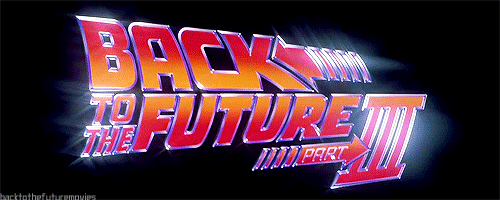
Spoilers below.
Have I seen it before: Yes
Did I like it then: Yes!
Do I remember it: Yes.
Did I see it in theaters: Yes.
Was it a movie I saw since August 22nd, 2009: Yes. #385.
Format: Blu-ray
1) I like really enjoy this film and I don’t know why. In some ways it is my favorite of the trilogy (but not really, the first one is my favorite). There are just so many things I love about it. The Western genre, the greater emphasis we get on Doc, Thomas F. Wilson as Mad Dog, there are just a lot of things about this film that really work for me on a base level. Outside of the original, this is the one I watch most of the trilogy.
2) Universal decided to unveil a new logo at the start of this film because 1) it was the studio’s 75th anniversary and 2) this was their most popular series at the time. It is the rare occasion when a logo actually adds to the weight of a film, as it feels more magical and we have a greater sense of time than we did with past logos.
youtube
3) Because the last film ended with the climax of the first film, and because this film’s opening scene was the ending of the last film (kudos if any of that made sense to you), this means that the end of the clock tower scene is the only sequence to appear in all three Back to the Future films.
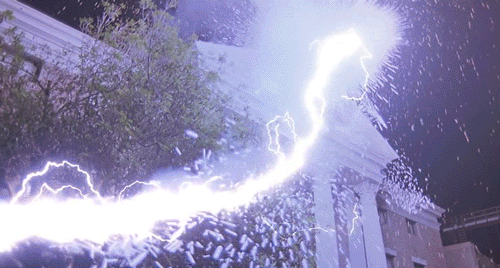
4) The film’s opening theme actually introduces a new love theme from composer Alan Silvestri. A lighter melody which reoccurs throughout the film which I always tied to Doc and Clara’s relationship. But in hindsight it could just as easily be used to relate Doc and Marty’s friendship.
5) I mentioned in my post about Back to the Future Part II that the sequels play with the idea of history repeating itself by recreating scenes from the original in new circumstances. This trend continues in Part III immediately when Doc doesn’t believe that Marty actually came back FROM the future and refers to him as, “future boy,” only for Marty to talk to Doc through a locked door and convince him otherwise.
6) Doc reading the letter his future self wrote to Marty from 1885 is great. We get to see a lot of fun from 1955 Doc in reacting to ideas like the flying Delorean and briefly thinking that, “Einstein,” was someone other than his own future dog. Also it makes both Doc & Marty tear up. I’m all for tearful bromances.
7) As I mentioned before, this film does succeed in some nice emphasis on Doc’s character. Before he was a funny enthusiastic scientist and we didn’t get MUCH of his backstory, but here we get nice little details which flesh out his character more. Notably, his love for Jules Verne inspiring his desires to be a scientist. We also learn that he LOVED the Old West and as a kid he wanted to be a cowboy. That’s such a fun idea!
8)
Marty [after finding a picture of his great-great-grandfather Seamus McFly, also played by Michael J. Fox]: “That’s him. Good looking guy.”
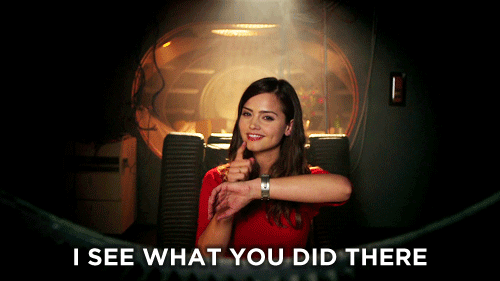
9) So Doc is about to send Marty into the old west dressed as a “cowboy” and Marty points out he never saw Clint Eastwood dress like this.

Doc: “Clint who?”
Marty [looking at the movie posters]: “That’s right. You haven’t heard of him yet.”
The movies featured at the drive-in - Revenge of the Creature and Tarantula -both actually feature a young Clint Eastwood in them!

10) According to IMDb:
The drive-in theater was constructed specifically for this film. It was built in Monument Valley, and demolished immediately after filming. No films were ever screened there.
I would have LOVED to go to that drive in. Like that would be a must see destination for sure.

11) This is a nice callback to the original:
1955 Doc (telling Marty about how he’ll have to drive through the desert): “Remember where you’re going there are no roads!”
12) The gag with the Native Americans is pretty clever. For those of you who haven’t seen the film: Marty is concerned about running into the drive in wall with the Native Americans on it but is concerned he’ll hit them, but Doc points out he’ll travel back in time when there was no wall. Except when he travels back in time, there’s a group of (possibly stereotypical) Native Americans charging right at him (because they’re being chased by the cavalry).
13) Michael J. Fox as William McFly.

Fox continues his excellence of acting out multiple characters from the first film with his performance as Marty’s ancestor Seamus. He plays it totally different than he does Marty. Quieter, kinder, a little less brash, and with a killer Irish accent. Like his acting in the previous film, you never feel like you’re watching Fox play against Fox. They’re two totally different characters and he does well to show that.
14) Not only does this film play well with preexisting gags, but it also adds to them.
Marty: I had this horrible nightmare. Dreamed I w-... dreamed I was in a western. And I was being chased by all these Indians... and a bear.
Maggie McFly: Well... you're safe and sound here, now, at the McFly farm.
Marty: McFly farm? (Marty jolts out of bed to see Maggie) Why, you're my, you're my, my...(realizes he’s never actually met this woman in his whole life, as opposed to all the times he’s done this with his mom.) Who are you?
15) Just as Fox plays Seamus well, Lea Thompson does a great job as Maggie McFly.

Maggie is so different from Lorraine or...huh, I guess she’s only played different versions of Lorraine before. But she’s a little fiercer, being an immigrant at all, is able to hold her own with her husband, and again the Irish accent is great! I very much enjoy Maggie.
16) Robert Zemeckis directed Who Framed Roger Rabbit before the two Back to the Future sequels...
youtube
17) Think about this: we have seen seven full generations of Marty’s family.
His great great grandparents, Seamus and Maggie.
His great grandfather, William (as a baby).
His grandparents, Sam and Stella (in the original film)
His parents and his mother’s siblings (in the original film)
His parents.
Him and his siblings.
His children.
That gets to an excellent point about this series: it’s not about random time travel, it’s very much about family and the relationships we form between blood and friends. The fact that we meet seven generations of one kid’s family I think illustrates that perfectly.
18) Marty wandering through town illustrates how he wanders through town in the earlier films, giving us some nice throwbacks/foreshadowing (I don’t know which it is in a time travel movie) when we see A. Jones Manure Company.
19) The three bar patrons:
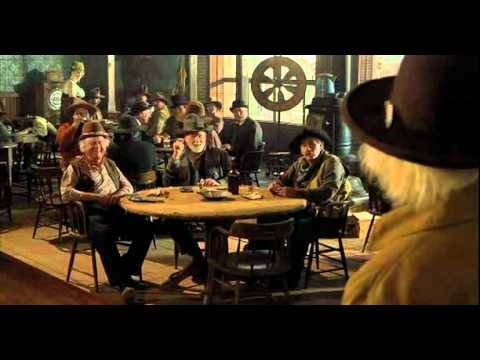
Dub Taylor, Harrey Carey. Jr., and Pat Buttram made careers out of playing sidekicks, town drunks, and colorful townsfolk in hundreds of westerns and television shows. Buttram in particular provided memorable voice over work in The Fox & The Hound as Chief and Disney’s Robin Hood as the Sheriff of Nottingham.
20) Bufford ‘Mad Dog’ Tannen.

This was Thomas F. Wilson’s favorite film to shoot out of the Back to the Future trilogy because he got to be a cowboy pretty much. Wilson is truly underrated throughout this film. In so many ways Mad Dog is a wildly different character from Biff and Griff. He’s more of a classic thug, he feels like he’s straight out of an old western and Wilson is chameleonic in the part. You don’t see Biff or Griff or any of other Wilson’s work, you just see Mad Dog and I will forever shout to the heavens that Thomas F. Wilson does not get enough credit for his work in this film.
21) These films really lucked out in their pop culture references. From the original we’ve had references to films, TV and music which have stood the test of time. These include Star Wars, “Star Trek”, Jaws, and - in this film - Clint Eastwood and Michael Jackson. Marty’s Michael Jackson dance when Mad Dog asks him to Dance is great!
22) In each film Marty pisses off a Tannen family member in a place to drink and is chased through town by him and his gang. This film is a bit more serious with that idea, as Mad Dog and his crew ride their horses and practically hogtie and lynch Marty. It’s the one time the town chase has not ended with Marty coming up on top, needing Doc’s sharpshooting to save his life. According to IMDb:
Thomas F. Wilson who plays Buford Tannen, performed all his horse riding stunts himself. He also did the trick where he lassoes Marty just before we meet the 1885 Doc.
When "Mad Dog" tried to lynch Marty, Michael J. Fox was accidentally hanged, rendering him unconscious for a short time. He records this in his autobiography "Lucky Man" (2002).
23) I never knew how amazing Doc Brown as a badass gunslinger would be until I saw this film.

24) It’s interesting to note that Doc does not remember helping Marty get to the Old West when he did so thirty years earlier. My working theory is this: we know that Doc hit his head a lot, so I’m guessing at some point he just banged himself up so much he forgot his own future in the Old West.
25) The Mayor in Part III was a part which was offered to Ronald Reagan after his presidency, as he was a fan of the original film. He ended up turning it down.

26) The whole idea of an act committed by Marty and Doc changes the name of Clayton Ravine to Shonash Ravine then to Eastwood Ravine is basically a more obvious version of the Twin Pines/Lone Pine Mall joke in the first film.
27) Clara Clayton.

With the exception of Lorraine, the Back to the Future films don’t exactly excel at representing female characters (they literally left Jennifer on the porch in the middle of the last film and she won’t show up again until the end of this film). Mary Steenburgen as Clara Clayton is a nice change of pace for that. Although largely introduced as a love interest for Doc Brown, she is developed into an interesting character to match Doc’s. She has the same love for Jules Verne and science as he does (a rarity in the Old West), she’s able to fend for herself around Bufford Tannen, but she and Doc also connect on a really fascinating level. Even though they just met, the chemistry between Lloyd and Steenburgen make you really believe that these two love each other (the scene where Doc agrees to fix her telescope is so cute!). I love Mary Steenburgen in this film, and she’s a worthy addition to the trilogy.
28) With the extension of the story to a trilogy, we get to see when the famous Hill Valley clock starts clicking in 1885 (in Part III) and when it stops clicking in 1955 (in the original film). Thinking it through, you can figure out exactly how long the clock ran. The clock in the clock tower started running at 8:00 p.m. on September 5, 1885 (the date is provided by the caption on the photograph Doc gives Marty at the end of the movie). The lightning strikes the clock tower at 10:04 p.m. on November 12, 1955. This means that the clock tower operated for exactly 70 years, 2 months, 7 days, 2 hours, and 4 minutes.
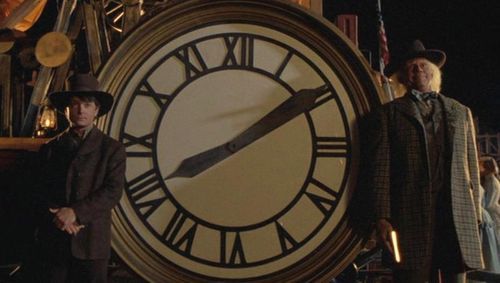
29) Much like how Huey Lewis made a cameo in the original film, ZZ Top (who sings the song “Doubleback” which plays during the credits) cameos as the 1885 town bad during the dance.
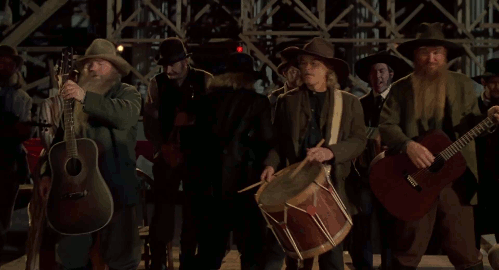
According to IMDb:
According to the book "Billy Gibbons: Rock & Roll Gearhead", ZZ Top was hanging around the set and was asked to be the town band. During one take, the camera broke. While waiting for the camera to be repaired, Michael J. Fox asked if they would play "Hey Good Lookin'" which they did. Afterwards, more requests were played. Two hours later, someone inquired if the camera had been repaired. Robert Zemeckis replied that it had been fixed for quite a while, he just didn't want to stop the party that had evolved.
Also the song they’re playing is an acoustic version of “Doubleback” from the film.
30) I’m sharing this largely for the first 22 seconds.
youtube
After watching the modern “Doctor Who” series I immediately think of this:
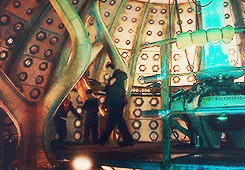
You Whovians get me.
31) I’ve seen this film probably around ten times (maybe eleven now) but this was the first time that the actor playing the Colt salesman looked familiar to me.

Well that’s because the last time I watched this film and my most recent viewing I’d see Blazing Saddles twice and, well...

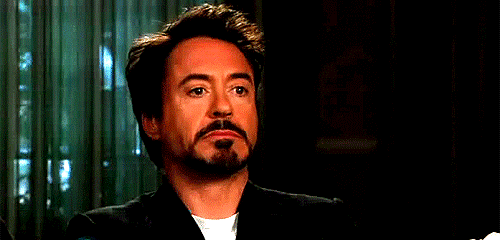
32) And of course this has to continue because it wasn’t resolved in Part II:
Mad Dog [to Marty]: “You yella?”
Again, I don’t have an issue with this as much as other people do, but it’s hardly my favorite aspect of the trilogy.
33) This part makes me laugh every time:
Mad Dog: Then let's finish it, right now!
Gang Member #1: Uh, not now, Buford. Uh, Marshal's got our guns.
Mad Dog: Like I said, we'll finish this tomorrow.
Gang Member #2: Tomorrow, we're robbin' the Pine City Stage.
Mad Dog: What about Monday? Are we doin' anything Monday?
Gang Member #1: Uh, no, Monday'd be fine. You can kill him on Monday.
Buford "Mad Dog" Tannen: I'll be back this way on Monday!
34) Doc and Clara stargazing melts my cynical heart.

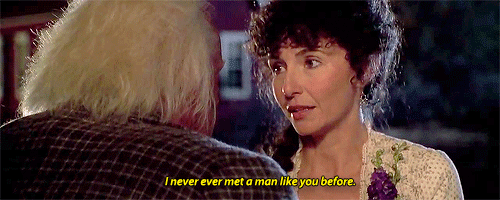

(GIF sources unknown [if these are your GIFs please let me know].)
35) The only time in the entire trilogy when the catchphrases are flipped!

(GIF source unknown [if this is your GIF please let me know].)
And I laugh every time.
36) It is a truly fascinating scene to watch when Doc tells Marty he wants to stay in 1885, but Marty knows Doc so well he is able to pretty easily convince him otherwise (mainly by appealing to the scientist in him). It shows just how great a friendship these two have.
37) You know what I never got: why does Doc not want to take Clara with them to 1985?
SHE’S SUPPOSED TO BE DEAD ANYWAY!!!!
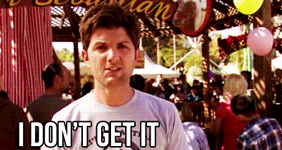
38) My heart breaks every time Doc tries to tell Clara the truth about himself, and each time I watch this film there’s a part of me that thinks it won’t happen this time. I’m always wrong.

(GIF originally posted by @whatshouldwecallme)
39) This fucking scene:
Doc [after a traveling salesman tells him you never know what the future holds]: “Oh...the future. I can tell you about the future.”
youtube
(Feel free to stop watching after 1:44)
40) I’m starting to realize this film has some of my favorite gags in the whole trilogy.
Marty [after Doc faints after taking a shot]: “How many did he have?”
Bartender: “Just one.”
Marty: “‘Just one’?”
Bartender: “Now there’s a man who can’t hold his liquor.”
41) Marty realizing what we all should when dealing with someone like Tannen:

(GIF source unknown [if this is your GIF please let me know].)
42) If I didn’t ship these two enough, just listen to how Clara describes Doc:
Clara [asking about Doc]: “Was this man tall, with great big brown puppy dog eyes and long silvery flowing hair?”
I love it!
43) Originally Mad Dog Tannen (after falling in manure) was arrested for killing Marshal Strickland and this was said by the deputy. However, this scene was deleted as the filmmaker decided it was too dark. They pointed out the fact that no one dies and stays dead in the Back to the Future films. Hence the re-dub.
44) When Doc blows the train whistle he gleefully exclaims, “I’ve wanted to do that all my life!” This sentiment would be repeated by the main character in 2004′s The Polar Express, also directed by Robert Zemeckis.

45) The entire climax with the train - while no Clock Tower scene from the original - is a great ride! It keeps the film’s standard for exciting and well done action in check while also feeding in incredibly into the western genre. It’s just a lot of fun!
46) This moment:
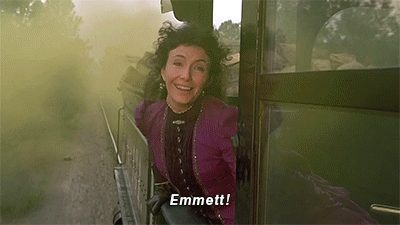
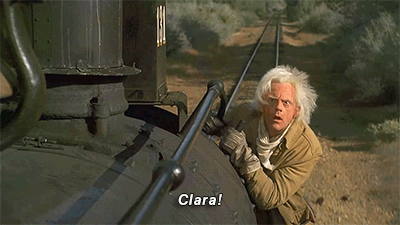
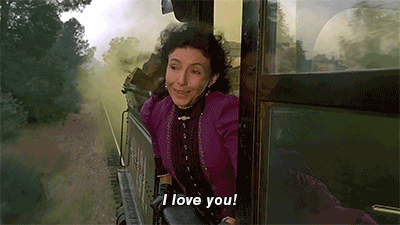
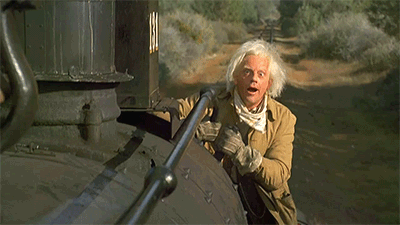
(GIFs originally posted by @gif-weenus)
HIS FACE! HE’S JUST SO HAPPY AND I LOVE IT! YES!!!!
47) It’s so sad when we think that Marty will never see Doc again because the Delorean is destroyed. Thank god for time travel.
48) Needles looks like a moron. Did people really dress this way in 1985?
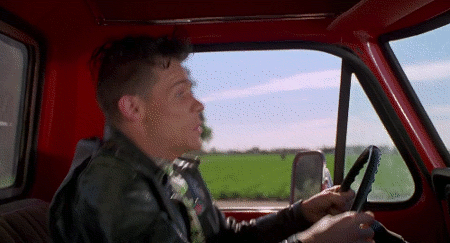
49) In the last film it was established that Marty got into a car accident with a Rolls Royce after being called chicken, a decision which sent his life spinning down the toilet. This time we see the scene itself and while Marty decides not to race Needles (and in doing so he avoids the accident), because of time travel something is different this time:
JENNIFER IS IN THE PASSENGER SEAT OF THE CAR! JENNIFER WOULD’VE FREAKING DIED!
That could’ve been very bad for Marty.
50) I have a lot of fan theories in my head that fill up a lot of plot holes, but one thing I can’t figure out is how did Doc get the barriers to the railroad to drop before he traveled back in the time train to meet Marty & Jennifer?
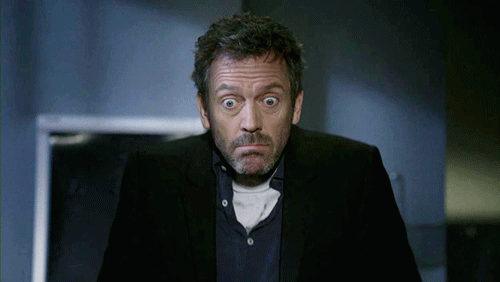
51) Jules & Verne.

If you watch carefully, you can see the younger of the two - Verne - doing random stuff with his hands during the wide-shot. That’s because a crew member was in charge of doing things with his hands that the child actor would mirror, mainly with petting the dog. But when the crew member started gesturing for someone to come by them Verne continued mirroring him. And it’s in the final film.
52) This is a great closing message for the entire trilogy.

I love Back to the Future Part III. I love all the Back to the Future movies honestly, but something about Part III just really does it for me. I love the Western setting, I love the emphasis on Doc, I think Lloyd and Wilson get to really shine, and Clara is such a wonderful addition to the story. It’s just a really great way to close out one of the best film trilogies in movie history! So go watch it! Not just this film, the whole trilogy. You won’t be sorry.
#Back to the Future#Back to the Future Part III#Christopher Lloyd#Michael J Fox#Mary Steenburgen#Thomas F Wilson#Lea Thompson#Robert Zemeckis#Epic Movie (Re)Watch#Movie#Film#GIF
10 notes
·
View notes
Text
Phantom of the Opera US tour review!
Went to see the re-staged tour of Phantom of the Opera yesterday. Being an extremely obsessed Phantom fan for pretty much my entire life, I have mixed feelings. (Long post ahead! Also spoilers, in case there’s anyone left who doesn’t know the show already...)
I wasn’t planning to see the new tour, since it isn’t the original staging, but the lure of hearing my favorite score performed live with a huge orchestra was too strong, and the new cast looked pretty good. (And included Trista Moldovan as Carlotta! Trista is one of my favorite Christines, so there was no way I could resist!)
The bright side: it wasn’t the completely awful trash nightmare I’d heard some of the hardcore phans say it is. The downside: the new sets are ugly and the new blocking really hobbled the storytelling. The original staging is perfect, and has stood the test of time- so why change it? That’s what I’d like to ask the people behind this, because it doesn’t make sense to me. I know budget concerns were supposedly a factor, but I don’t see how that giant turntable set could be less expensive than a staircase and a portcullis! The one thing I will give it: the staircase magically appearing as they descended to the Phantom’s lair was pretty cool, but I still prefer the original with the whole stage filled with mist and candelabras, it was more atmospheric.
The places where this production was at it’s best were where it stuck most closely to the original. The opera scenes were the best in that respect- and I even liked this version of ‘Il Muto’ better than the original- they had a whole Rococo boudoir set with a cabinet for the Count to hide in, it was very pretty and made it more funny. That was the only place where I can say this production improved on the original. The opening sequence was my favorite though, and I was having a bit of a squee moment when the overture started and the chandelier lit up and all the Hannibal dancers appeared. I also liked the cobwebbed effect over the prologue that dissolved away as the overture started- I thought it was painted on a scrim, but it was actually some sort of projection- very cool! And I forgot that Carlotta also sings ‘Think of Me’ at the beginning, so I nearly flipped out that my favorite Christine was singing ‘Think of Me’ live in front of me! (WHY IS SHE NOT STILL PLAYING CHRISTINE?! SHE’S NOT TOO OLD COME ON PEOPLE! SO CLOSE AND YET SO FAR!!) Not to count out Kaitlyn Davis, who was perfectly fine as Christine, and sang a lovely cadenza (I love that they let her use a different one from the Broadway version!), but Trista is my fave and I’d choose her over everybody. Except Gina Beck- I don’t think I could choose between Gina and Trista- don’t ever ask me, I can’t do it!
The use of the original costumes (or most of them, at any rate!) was what saved the whole production from looking like a pathetically cheap bargain basement version. Except for ‘Masquerade’, which they really skimped on, and it looked awful- if you take away the original costumes, including the Phantom’s iconic Red Death costume, AND the staircase that was utilized in both the dance and the Phantom’s entrance, then you’re left with a scene that has almost no impact, or even reason for existing. But Christine’s Star Princess costume was one of the prettier ones I’ve seen- nicely subdued colors, and the skirt was all sparkly like a field of stars- I wasn’t close enough to see how it was constructed, but it looked like a net overskirt with rhinestones, maybe? But it was so much better than most of the really brightly colored, less embellished ones they seem to use nowadays.
The loss of atmosphere was the big problem with the sets: they were mostly just backdrops of brick walls. I guess they were trying to show the ‘backstage life’ of the theater, but it took away from the Gothic Victorian romanticism aesthetic that’s so much a part of what makes the show beloved. In a dramatic sense, switching the action of ‘Angel of Music’ to take place in the ballerina’s common dressing room rather than a luxurious private dressing room for Christine still makes sense, even if it’s less pretty to look at, but changing the Phantom’s lair was just glaringly wrong. It literally looked like a basement: just brick walls with a bed and a desk. (Well, it was supposedly an organ- like a smaller, steampunk version of an organ that the phantom had invented, but it looked like a desk, not an organ.) There’s no candelabras, no portcullis, no throne. There’s a bunch of candles hung from ropes from the ceiling, but it just looks like a student’s modern art project rather than something someone in the 19th century would actually do, particularly someone like the Phantom. All the opulence he surrounds himself with is part of his persona, and helps create his character for the audience- he feels somewhat incomplete without it. Also, taking leaves from the movie adaptation and actually showing the Phantom killing Buquet onstage, or having Raoul punch him in the jaw in the graveyard, undercuts his supernatural persona and makes him seem less mysterious, which lowers the dramatic stakes, and undoes some of the glamour of the character.
That said, Derrick Davis was very good. He has a fantastic voice, and I hope he gets the chance to play the role on Broadway, because I feel like we didn’t see the best of what he could do, because this version’s terrible blocking took away so much character development. Being nearly a through-sung show, the big songs are also the big moment to build the relationships between the characters, but the new director seems to think that having two characters stand motionless several feet apart and sing at each other from afar is enough to do that- and it’s not. ‘Music of the Night’ is all about the Phantom & Christine establishing some kind of emotional/sensual connection, but it was just awkward here. It’s a running joke in the phandom that Christine has a ‘phantagasm’ when the Phantom touches her in MOTN, but certainly not in this version. There’s nothing remotely sensual about this blocking- it’s pretty business-like for most of it, including when he blindfolds her for goodness knows what reason, leads her around in a dance hold for a few seconds, then they go back to standing motionless a few feet away from each other again, until he picks her up and puts her to bed. (Why she immediately falls asleep isn’t explained, we’re just supposed to go with it. Okay. Whatever. But really, bring back the mirror bride asap!)
The same trouble plagued ‘All I Ask of You’. It’s usually my favorite, because it’s just so romantic and sweet, but that doesn’t come through in this version. Raoul & Christine’s relationship should be demonstrated through their mutual affection as they’re hugging and canoodling in this song, but in the new blocking it can’t. They stand on opposite sides of the stage until halfway through- Christine actually runs away from Raoul and looks more afraid of him than the Phantom! Add to that the weird set design- why are those brick walls on both sides of the stage if they’re on top of the roof?! I couldn’t even see the entire rooftop set from where I was sitting because of those darn wall pieces blocking the view- why were they there?!- and you’re left with an oddly flat love song. It’s a shame too, because everyone in the cast had a great voice, and it sounded lovely, but that was it. Raoul in particular felt kind of rigid and unemotional, but I wonder how much of that is the director’s fault, since Andrew Lloyd Webber wants the new staging to set up Love Never Dies, so they’ve deliberately tried to make Raoul less likable to do that, which I hate! You could tell they did that with Hadley Fraser at Royal Albert Hall and it was so disappointing. LND will never have an American production, so don’t ruin POTO just for it’s sake. Raoul should always be sweet and adorable. End of story.
On a positive note, they’ve clearly taken a few notes from the phans complaints and made some minor changes from the UK tour- the Phantom’s mask is less ugly than the one you see John Owen Jones wearing in the TV commercial, and his wig is less full and more controlled than the floppy haired ones they used in the UK, thank heaven, but I’d still prefer the return of the slicked back wig. And Christine now has her scarf back during ‘Think of Me’. Also, I don’t know if it’s just Derrick Davis, or if they’ve officially changed it, but I’m glad he’s less aggressive toward Christine in the Final Lair scene. The choking is still a major problem and they really need to find some alternative to that, but at least he didn’t get on top of Christine in that aggressive rape-y stance when he throws her on the bed, like previous Phantoms in this production did. That was one of the reasons I didn’t have interest in the touring show- it changes the Phantom’s character, and it’s really inappropriate for a show that lots of children know and love, not to mention triggering for a lot of people, and I wasn’t gonna support that. But when I watched a bootleg of Derrick, he didn’t do that, so I decided I could give it a chance after all. (Note to producers: bootlegs are your friends, not your foes!)
Also, an interesting costuming tid-bit: Kaitlyn Davis was wearing the rare, elusive, non-striped blue dress for ‘Wishing You Were Somehow Here Again’! I’ve heard tales of this phenomenon, and seen a few pics, but it was a surprise to actually see it in person! And it was a pretty one, too: dark blue floral print on a lighter blue background. I admit that trying to find a good match for cosplaying the stripey dress has been a lifelong goal, but it’s impossible! However, I’m wondering now if cosplaying this version might be more do-able. I’m gonna keep it in mind as an option now :)
So overall: it was a mixed bag. I didn’t like the new design or direction, but the whole cast was very good, and I liked them a lot. (I thought the main trio was especially good in the Final Lair scene- if only it had been the original staging!) I’m disappointed that it didn’t have the emotional impact that the original had, but it was still an entertaining show, and I enjoyed all the little funny moments that you don’t get from just listening to the cast album or watching grainy bootlegs. (When Carlotta swished her Hannibal skirt and caught two of the ballerinas underneath it, and they crawled out and rolled their eyes! LOL) And of course, seeing the original costumes in action from moderately close-range was a dream come true after all these years!
It wasn’t the perfect Phantom experience, but it was still fun, and it was certainly worthwhile. It can’t replace the original, but it was an adequate place-holder if you don’t have access to the real thing. The music, after all, is all still there, and if it makes some little kid falls in love with the show, and maybe musical theatre in general, I think it’s still doing it’s job. I saw a matinee, and there were two bus loads of school kids in the audience, and it was great to see how excitedly they were talking about the show afterward. I even saw a little boy in the lobby before the show who couldn’t have been more than four years old, but he was wearing a little tuxedo, cape, and mask, clinging to his mothers hand and asking her when they were going to see the Phantom. (Awwww!) I’m just glad the show is still out there in some form garnering new phans, because that’s what’s going to keep it alive for years to come. :)
2 notes
·
View notes